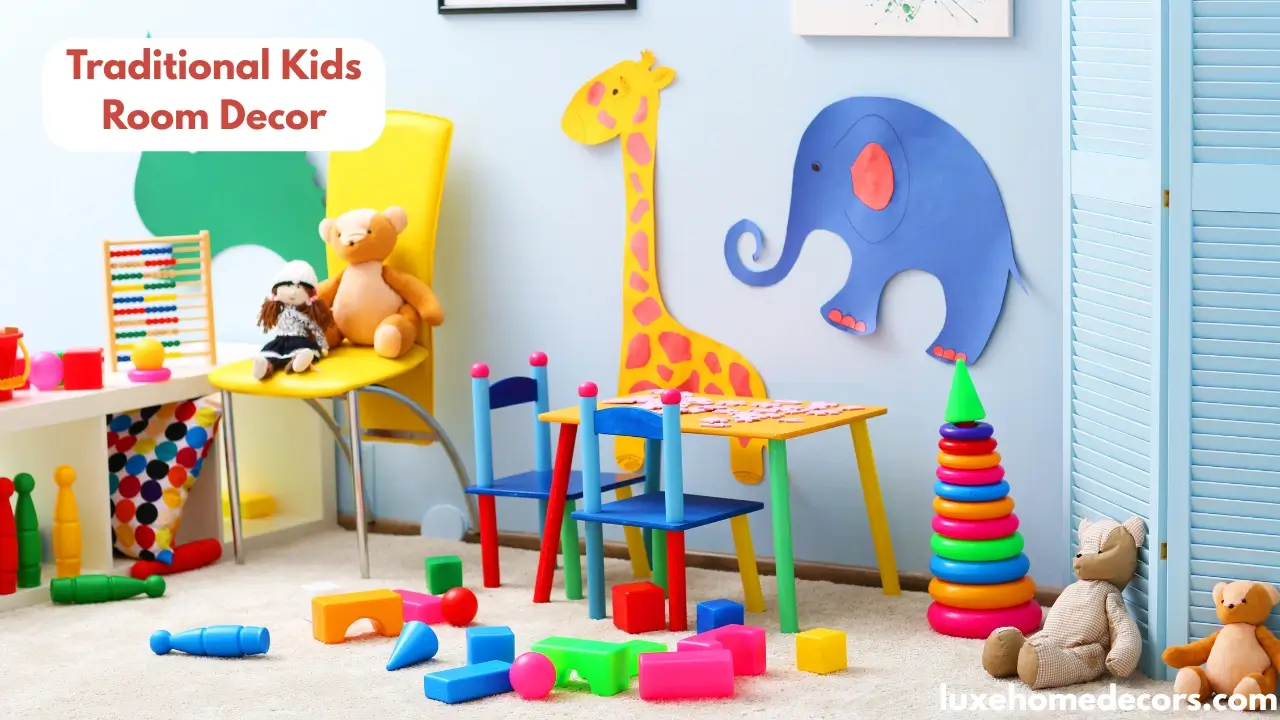The traditional kids room decor guide gives you new ideas to create a kid-friendly room. By reading this guide, you can create a space that feels warm and practical. Furniture, colors, and patterns can easily be decorated with my instructions.
You don’t need to chase every new trend; just read this guide. I explain about 80 decor ideas for your kids room to give a traditional feel.
- 1. Matching Beds
- 2. An Ode to Hobbies
- 3. Neutral with Vintage Details
- 4. Framed Personal Artwork
- 5. Cozy Bunk Beds
- 6. A Muted Color Palette
- 7. Fun Statement Furniture
- 8. Wallpapered Ceiling
- 9. Purpose and Style Mixed
- 10. Glam Pop of Pink
- 11. Keep It Simple
- 12. Play with Patterns
- 13. Build a Reading Spot
- 14. Shared Room Zones
- 15. Add Whimsy with Rugs
- 16. Small Details Shine
- 17. Nature Inside
- 18. Creative Wall Storage
- 19. Soft Lighting Choices
- 20. Personal Touches Matter
- 21. Keep the Floor Clear
- 22. Use Mirrors
- 23. Add Colorful Curtains
- 24. Play Zones Inside Rooms
- 25. Built-In Desk Area
- 26. Layer Bedding
- 27. Add a Canopy
- 28. Wall Decals for Easy Change
- 29. Use Multi-Use Furniture
- 30. Bright Play Rugs
- 31. Add Open Book Shelves
- 32. Bright Ceiling Lights
- 33. Use Wall Hooks
- 34. Add a Chalkboard Wall
- 35. Mix Soft Textures
- 36. Add a Study Nook
- 37. Use Bunk Beds with Storage
- 38. Wall Art with Meaning
- 39. Add Play Tents
- 40. Color Block Walls
- 41. Add Window Seats
- 42. Use Striped Walls
- 43. Floating Shelves for Decor
- 44. Add a Soft Corner
- 45. Two-Tone Walls
- 46. Add a Theme Wall
- 47. Use Under-Bed Storage
- 48. Add Fun Chairs
- 49. Try Layered Lighting
- 50. Use Open Shelves
- 51. Add a Loft Bed
- 52. Try a Color-Drench Look
- 53. Use Sliding Doors
- 54. Create a Music Corner
- 55. Choose Flexible Furniture
- 56. Hang a Chalkboard Wall
- 57. Pick Statement Lighting
- 58. Add Window Seating
- 59. Use Open Shelving
- 60. Make a Theme Wall
- 61. Build a Tent Corner
- 62. Add a Pinboard Wall
- 63. Layer Different Rugs
- 64. Try Hanging Chairs
- 65. Create a Craft Station
- 66. Add Canopy Beds
- 67. Install Pegboards
- 68. Mix Old and New Pieces
- 69. Try Built-In Storage
- 70. Use Bold Curtains
- 71. Create a Reading Loft
- 72. Use Floor Cushions
- 73. Add Glow-in-the-Dark Details
- 74. Display Favorite Collections
- 75. Try a Nature Corner
- 76. Add Wall Murals
- 77. Use Ladder Shelves
- 78. Create Hidden Storage
- 79. Add Swing Seats
- 80. Try Patterned Bedding
- You may also like these guides
- Conclusion
1. Matching Beds
Matching bed frames make a shared room look tidy and complete. They bring balance when kids share the same space.
Add unique pillows, blankets, or toys to show personality. Small touches keep the room from feeling identical. It’s a neat way to combine order and individuality.
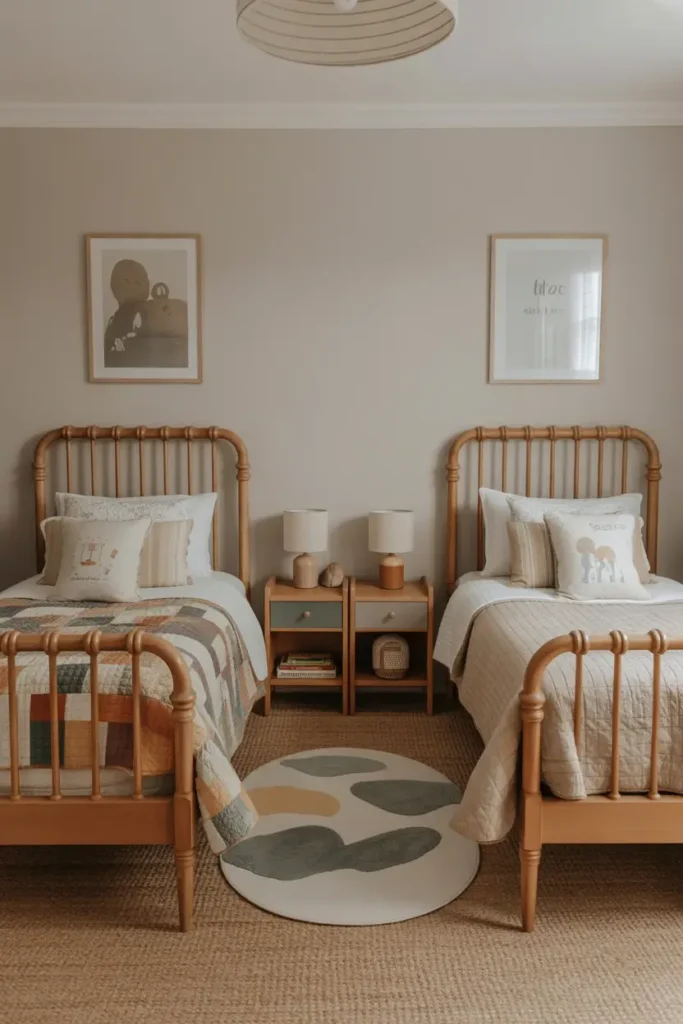
2. An Ode to Hobbies
A room that reflects hobbies feels both fun and personal. A swing, a hoop, or small instruments give kids choices.
Keep the setup light to avoid clutter. A simple rug grounds the space and adds comfort. The room stays playful without feeling crowded.

3. Neutral with Vintage Details
Neutral colors work well when tastes change often. Soft walls and simple bedding make updates easier later.
Antiques give a room personality without taking over. A small desk, lamp, or chair creates warmth. The balance feels timeless and practical.
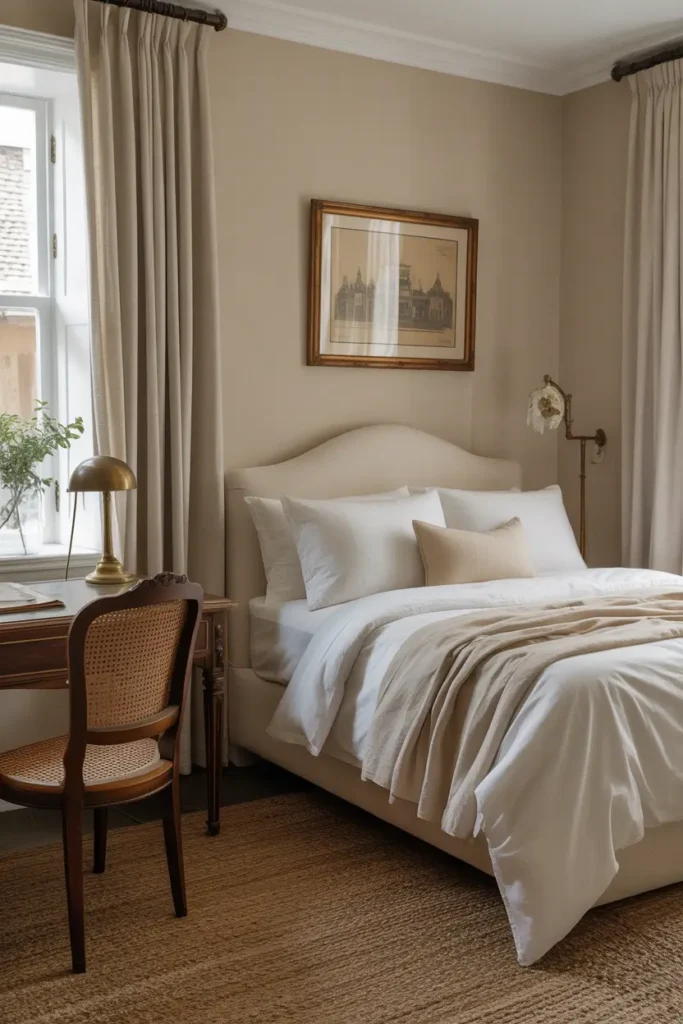
4. Framed Personal Artwork
Framing children’s own art makes the room personal and uplifting. It adds color without needing store-bought decor.
Frames make drawings look neat and polished. Changing artwork keeps walls fresh as kids grow. The space becomes a gallery that evolves naturally.
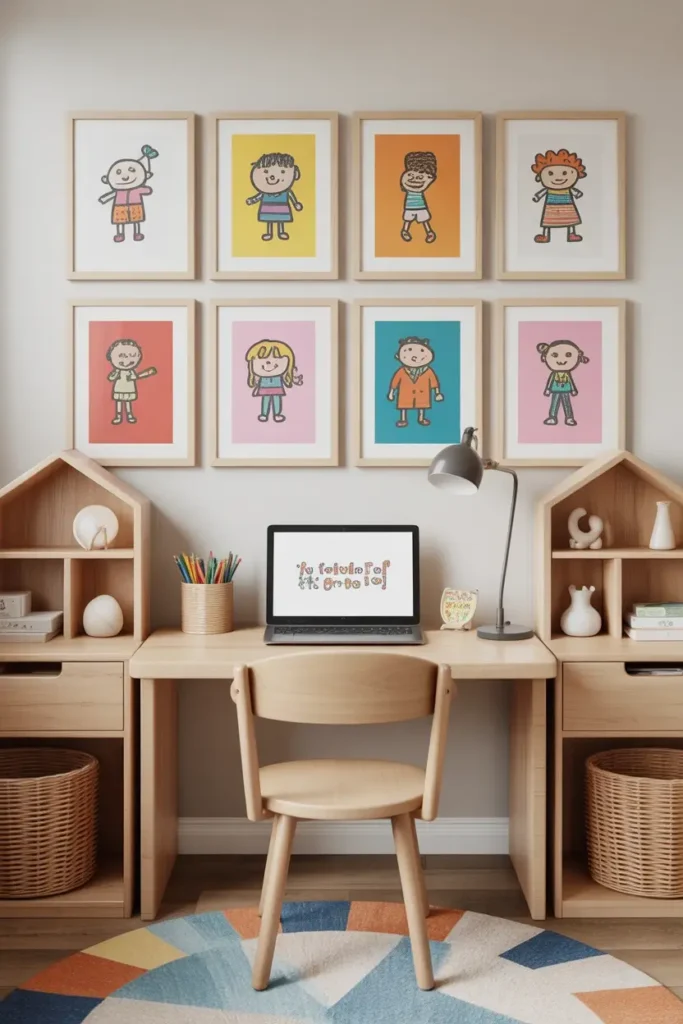
5. Cozy Bunk Beds
Bunk beds save space and create a close setting for siblings. Wood paneling or warm colors make them inviting.
Soft bedding adds comfort and helps kids feel secure. Built-in shelves keep the area organized. The setup blends function with coziness.
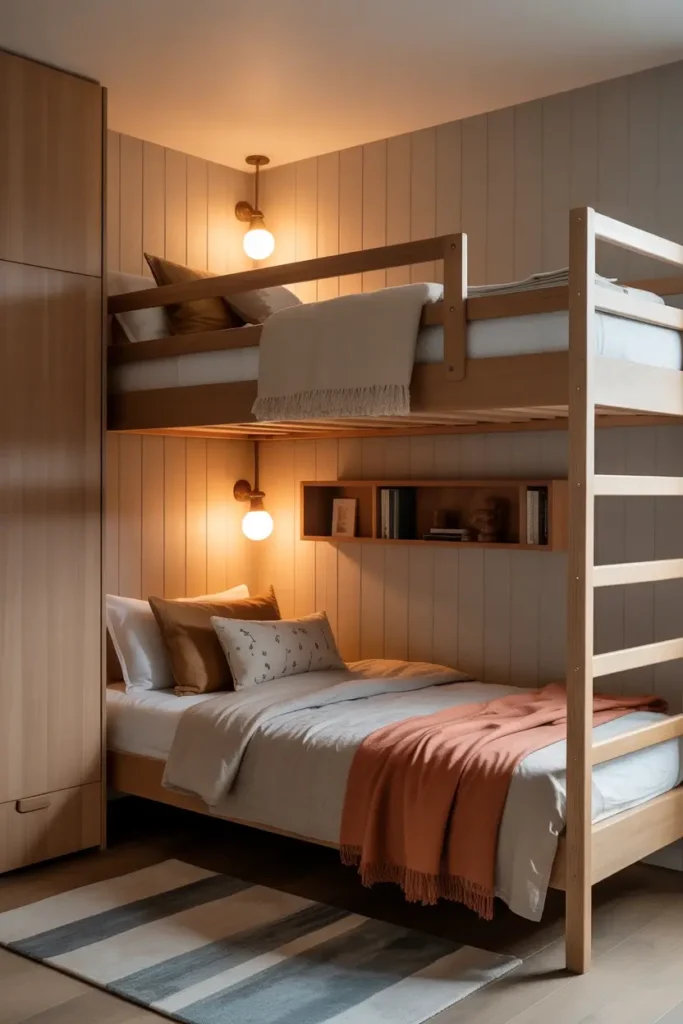
6. A Muted Color Palette
Muted colors create a calm and gentle setting. Shades like soft blue, pale pink, or moss green feel balanced.
These tones work well as kids’ preferences shift. Add pillows, rugs, or art for subtle variety. The result is soothing yet not dull.
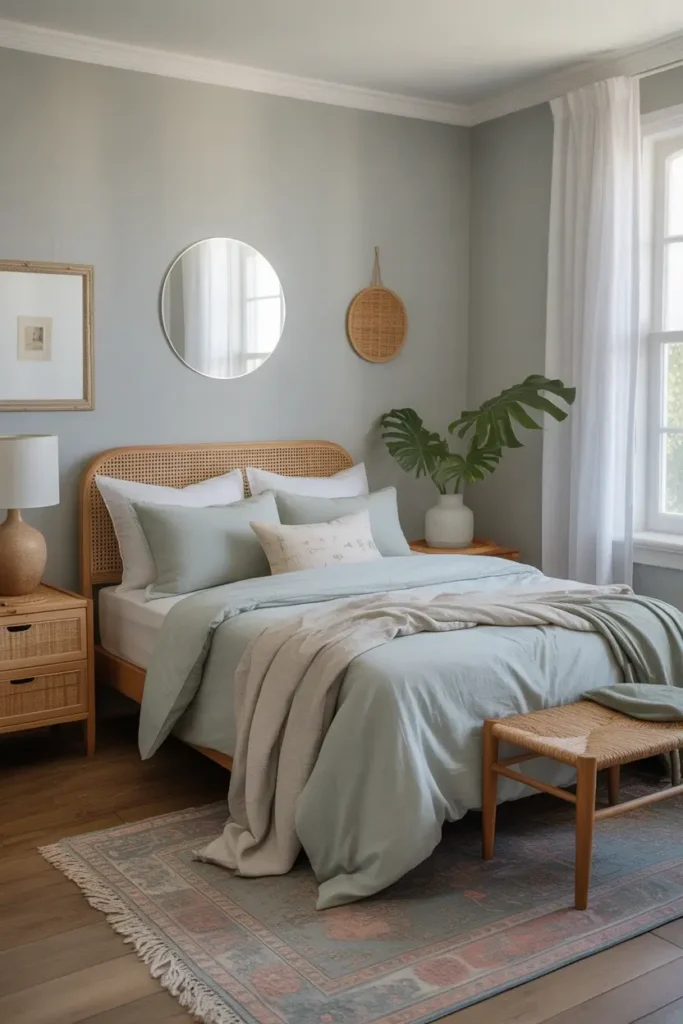
7. Fun Statement Furniture
Furniture with character turns a room into something memorable. A bold chair, patterned dresser, or shaped bed stands out.
These pieces double as both function and decor. Keep other items simple to avoid overwhelm. One playful detail is often enough.
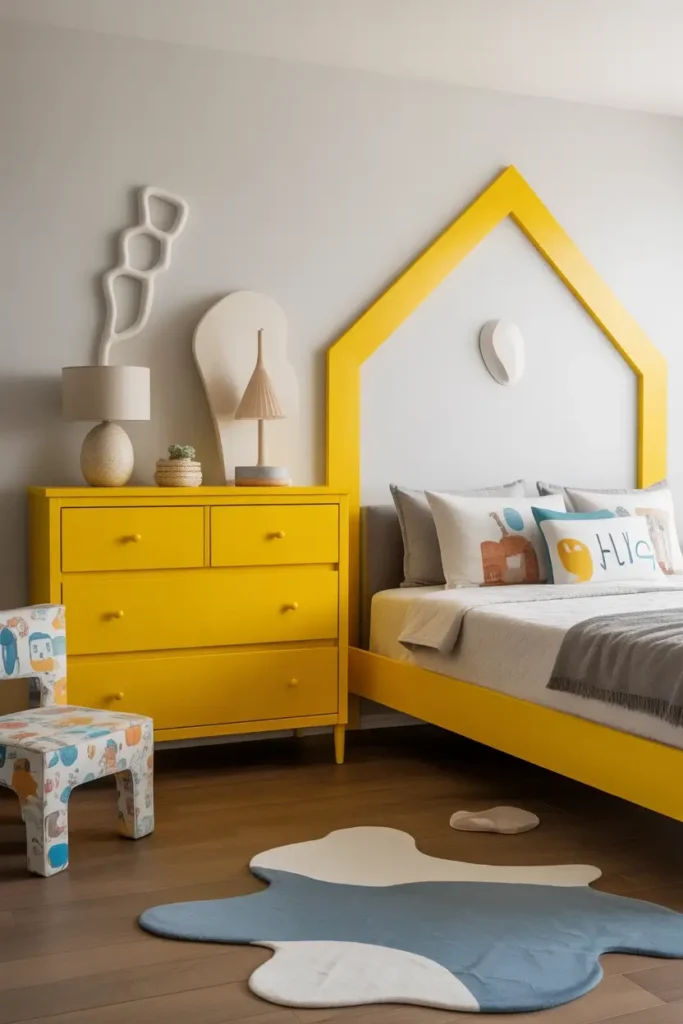
8. Wallpapered Ceiling
A decorated ceiling adds surprise to a child’s room. Patterns or colors overhead feel creative and fun.
It draws the eye upward, making the space bigger. A pendant light completes the effect neatly. Removable options make future changes easy.
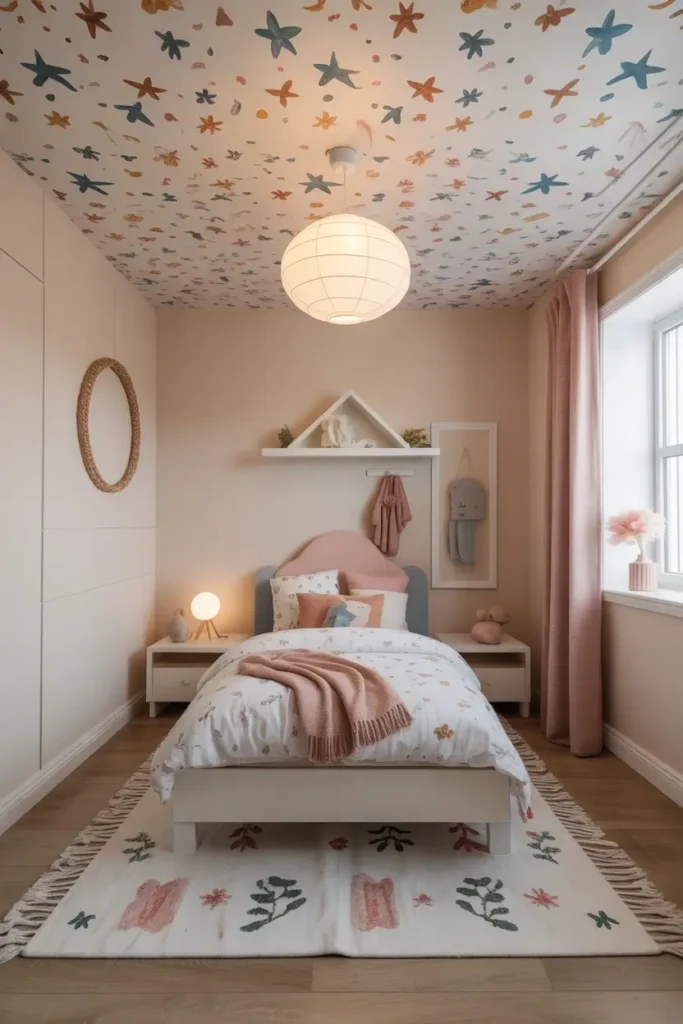
9. Purpose and Style Mixed
A child’s room works best when purpose guides the design. Decide if it’s mainly for sleep, study, or play.
Use furniture that supports those needs clearly. Mix style with function for balance and comfort. The room feels beautiful and useful at once.
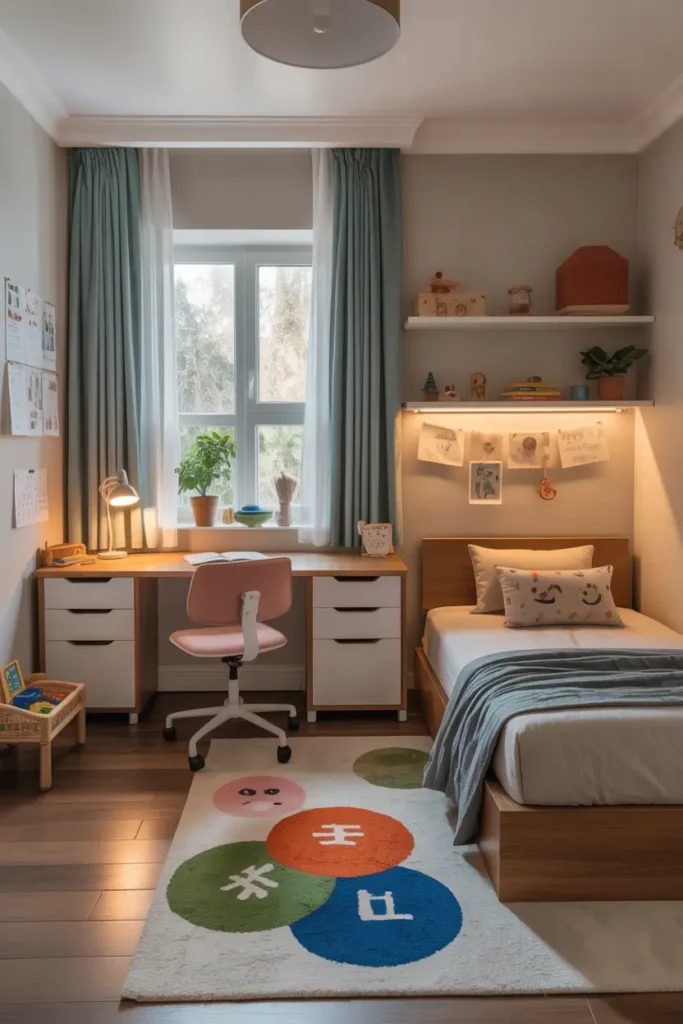
10. Glam Pop of Pink
Small bursts of bright pink add energy without overdoing it. A lamp, throw, or mirror works as a test.
If kids love it, add more over time. Bright accents feel playful but remain easy to swap. The space stays flexible and colorful.
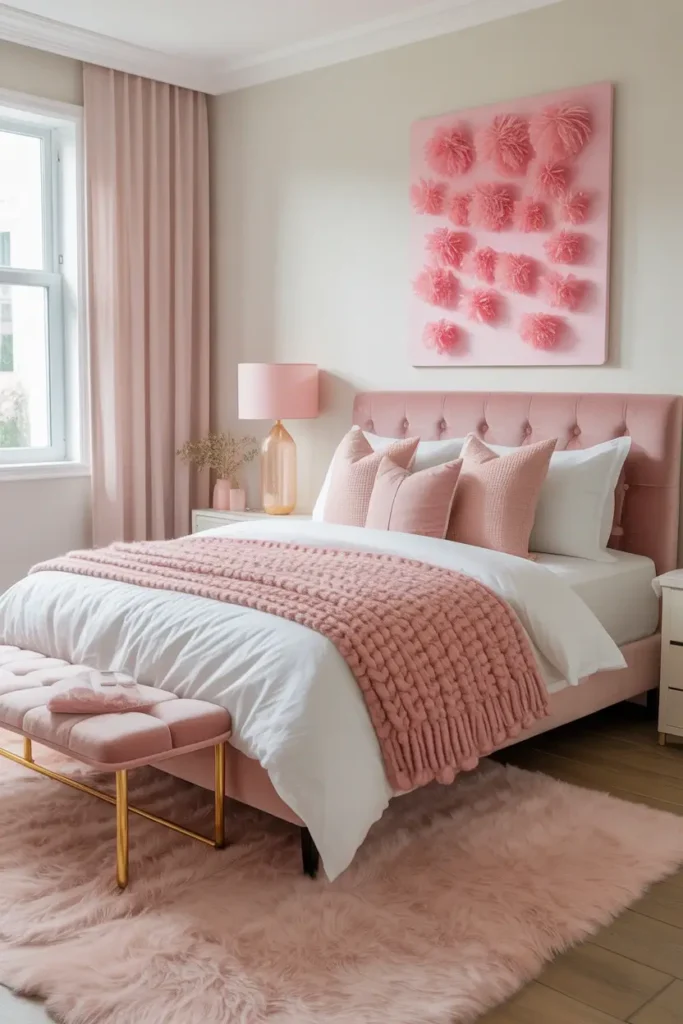
11. Keep It Simple
A simple room setting helps your kids focus and relax. Many patterns or colors can feel overwhelming.
Neutral walls pair well with playful accents. Furniture with clean lines keeps the room uncluttered. The space feels open and easy to enjoy.
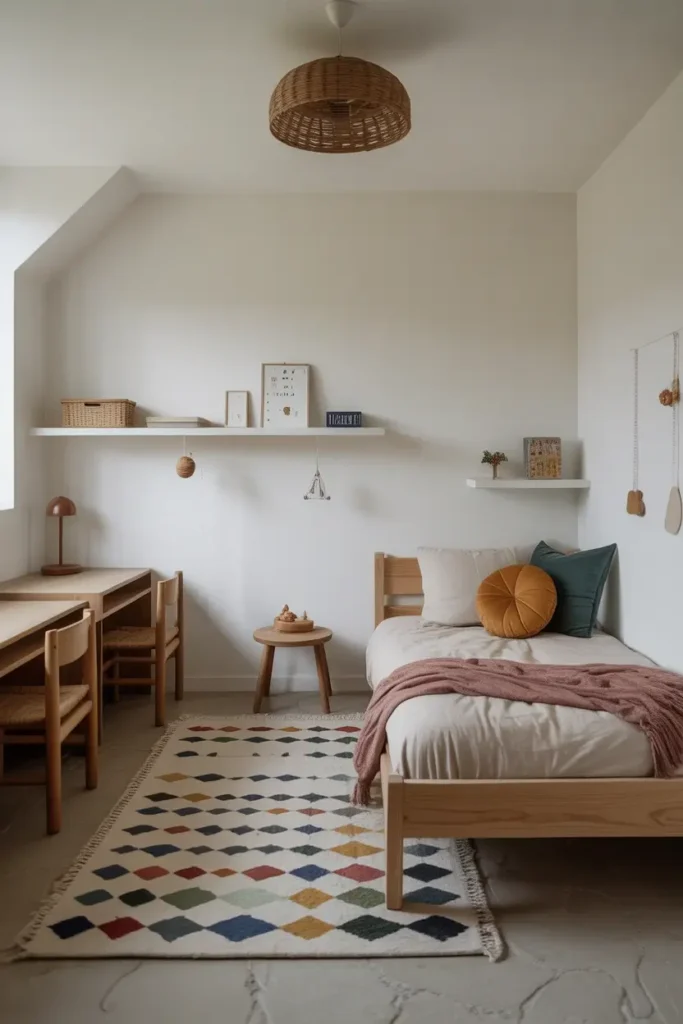
12. Play with Patterns
Patterns bring energy when used thoughtfully. Stripes, dots, or checks add character without chaos.
Use them on bedding, curtains, or rugs for balance. Keep walls plain to avoid much busyness. A few touches make the room lively and fresh.
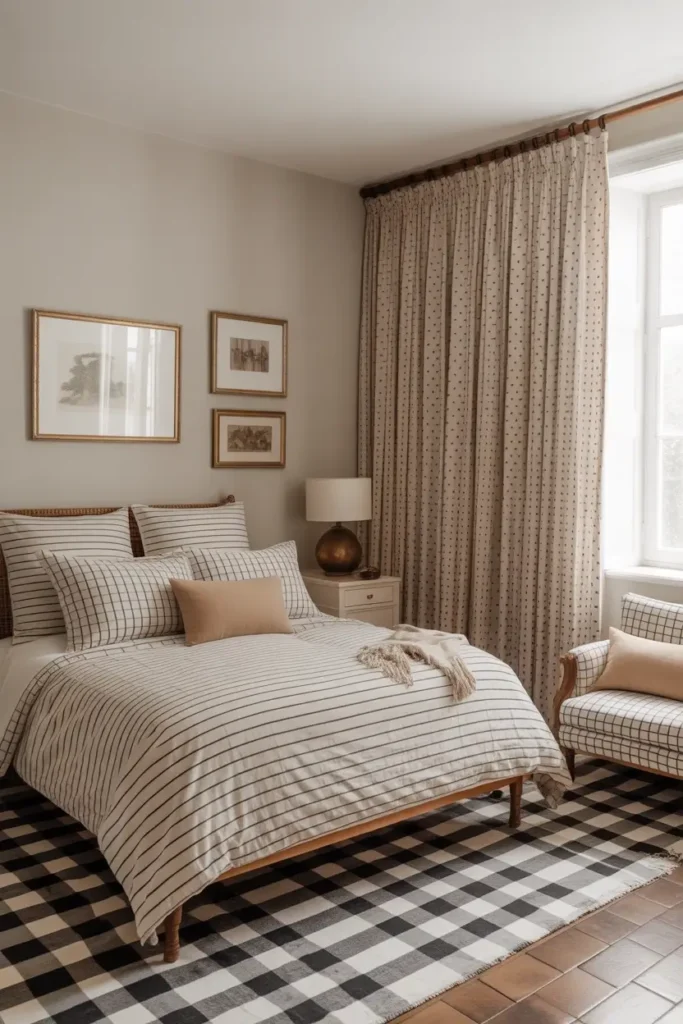
13. Build a Reading Spot
A cozy reading corner encourages quiet time. A small chair, soft light, and a basket of books work well.
This area feels special while staying simple. Add cushions or a throw for extra comfort. Kids enjoy having a retreat within their room.
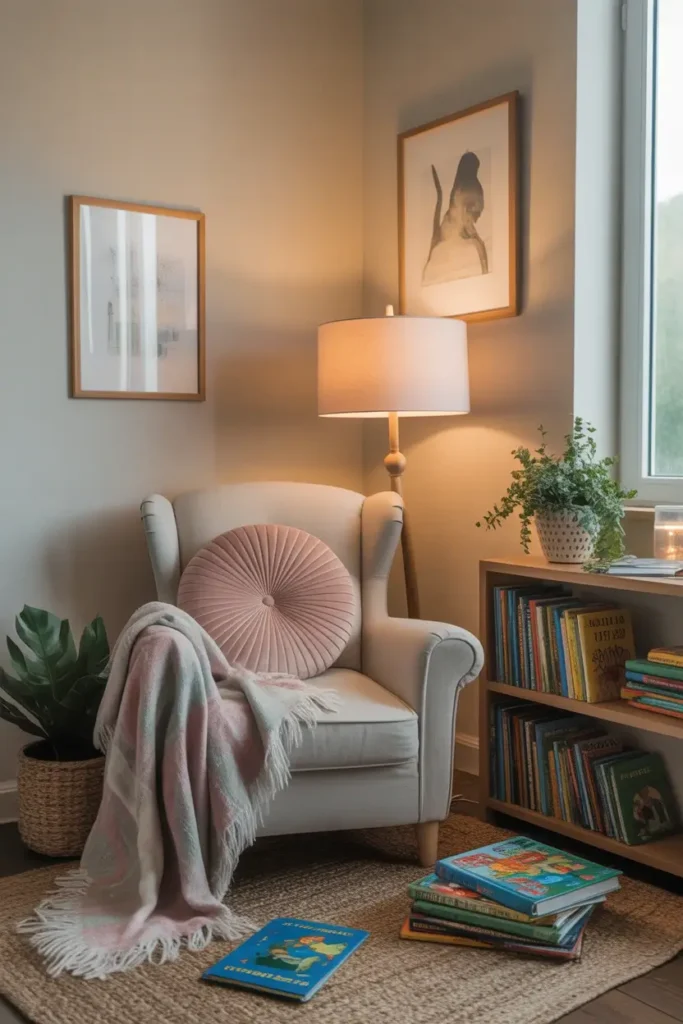
14. Shared Room Zones
Clear zones keep a shared space fair and organized. Beds, desks, and shelves can divide naturally.
Each child gets their own defined corner. Use rugs or wall colors to mark areas subtly. The layout prevents clutter and avoids arguments.
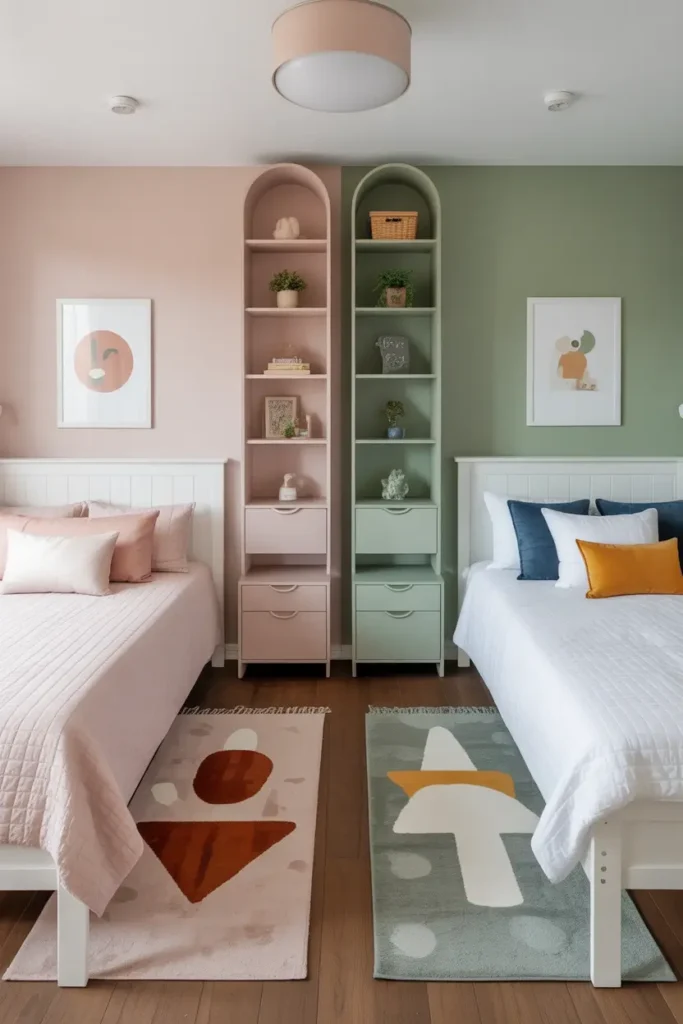
15. Add Whimsy with Rugs
A playful rug quickly changes the feel of a room. Bright shapes or animals bring instant charm.
Rugs soften the floor and invite play. They also add warmth to wood or tile. A single rug can anchor the whole design.
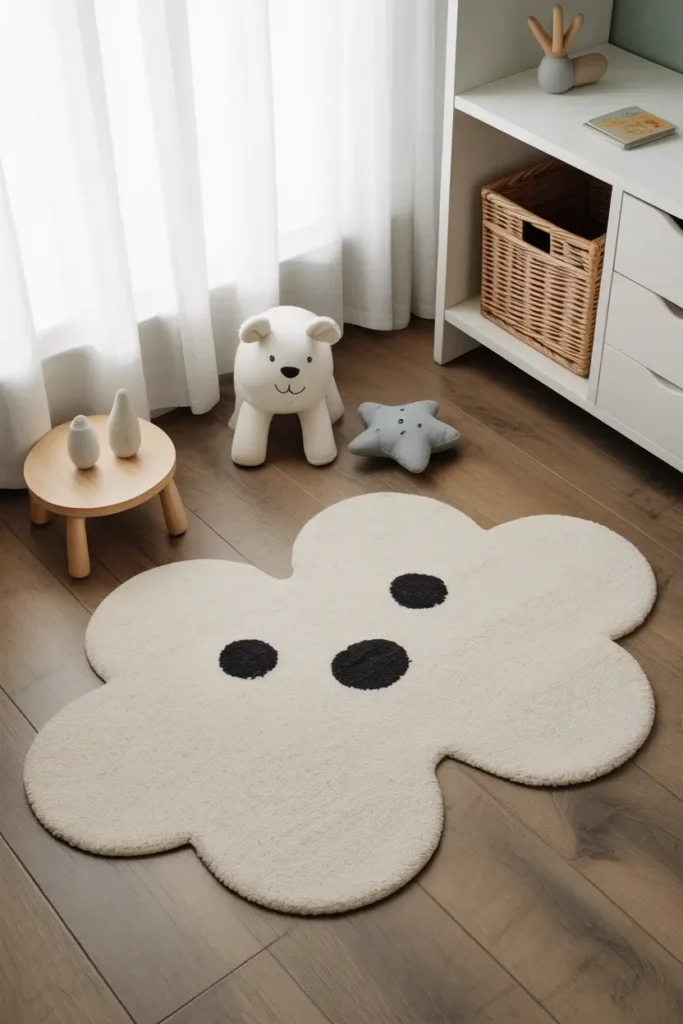
16. Small Details Shine
Little touches often make the biggest difference. A patterned pillow, soft blanket, or colorful rug changes the mood.
Details add warmth without heavy expense. They’re easy to swap as kids grow. Start small, and the room still feels fresh.
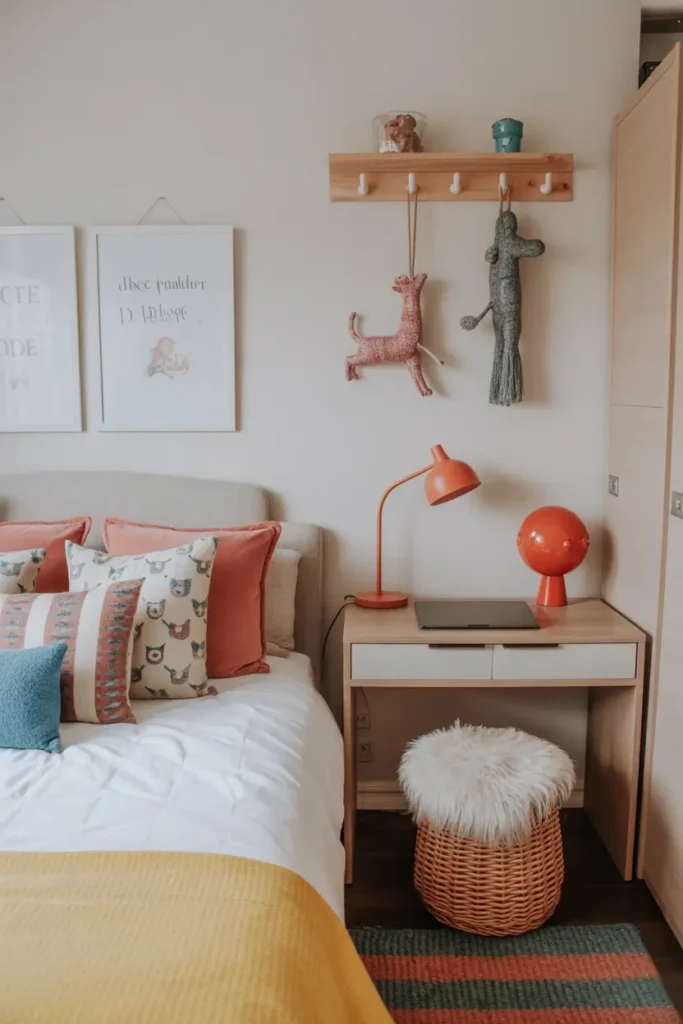
17. Nature Inside
Natural elements bring calm into a child’s space. A small plant, wooden shelf, or rattan chair adds texture.
These materials connect the indoors with the outdoors. They’re durable and look good in any theme. The room feels grounded yet playful.
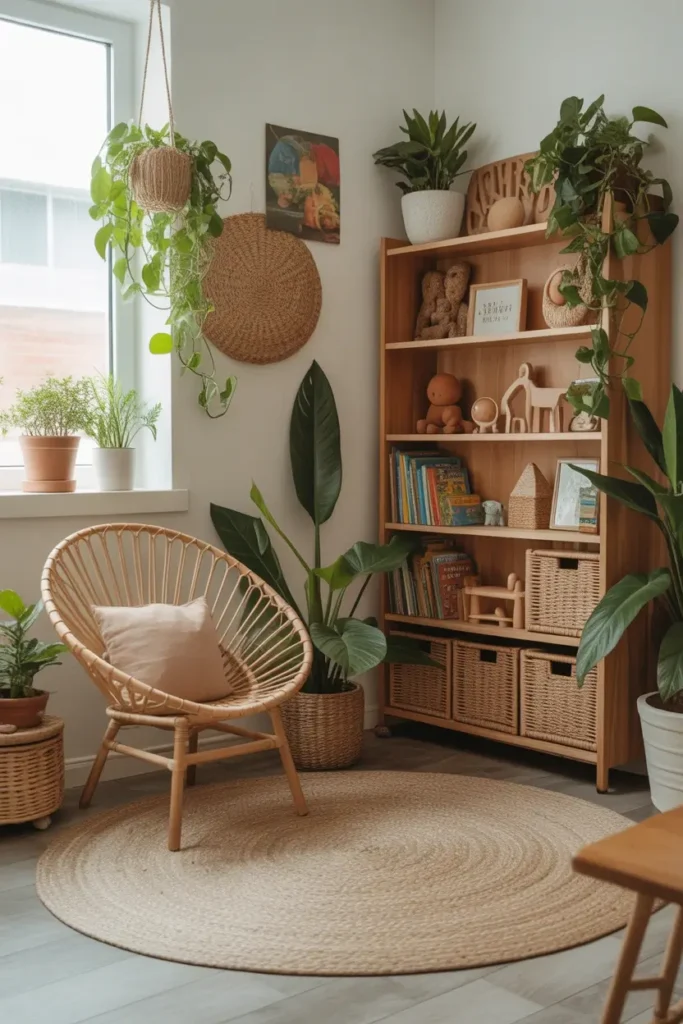
18. Creative Wall Storage
Wall-mounted storage frees up the floor for play. Hooks, shelves, and pegboards keep essentials close.
Open displays help kids find what they need. Closed bins keep smaller items neat. Vertical storage makes the room feel larger.
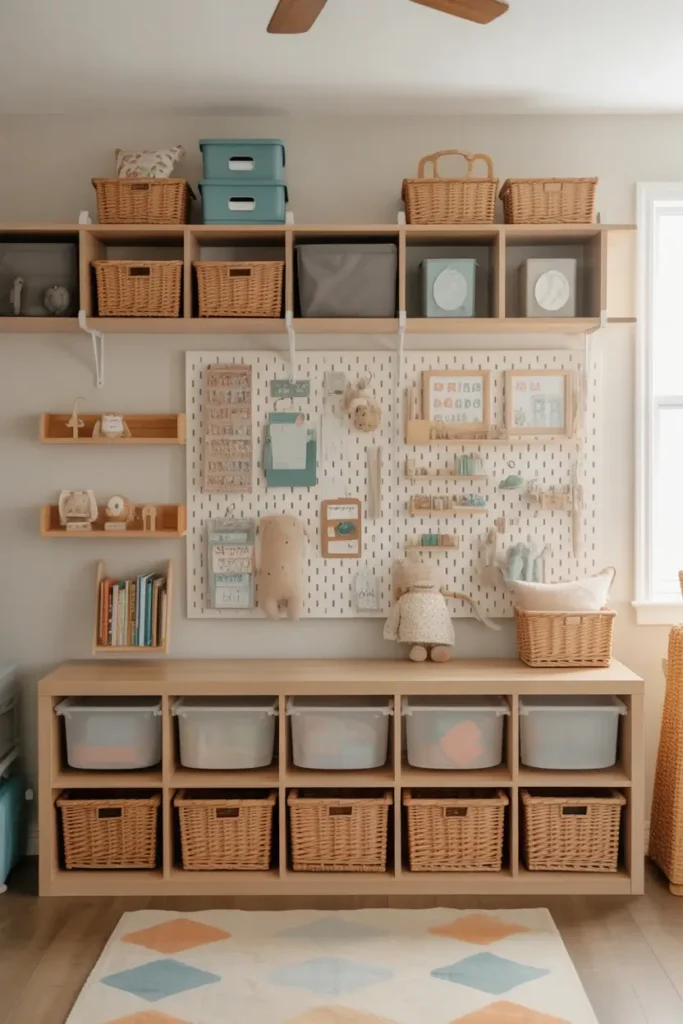
19. Soft Lighting Choices
Good lighting changes how a room feels. Lamps, string lights, or a small nightlight add comfort.
Overhead lights work for study or play. Softer lights make evenings calm and cozy. Different options let the room adjust to every need.
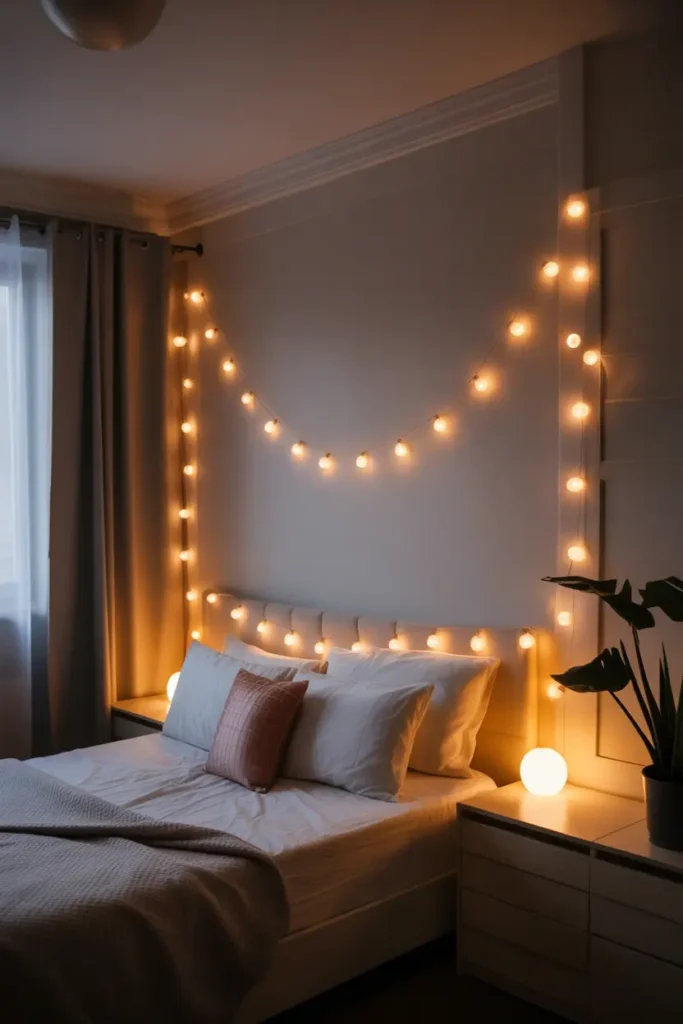
20. Personal Touches Matter
A room feels more special when you add some creativity. For example, like some Display photos, favorite books, or handmade crafts.
These details make the space feel like home. Kids connect better with a room that reflects them. Personal touches bring joy without effort.
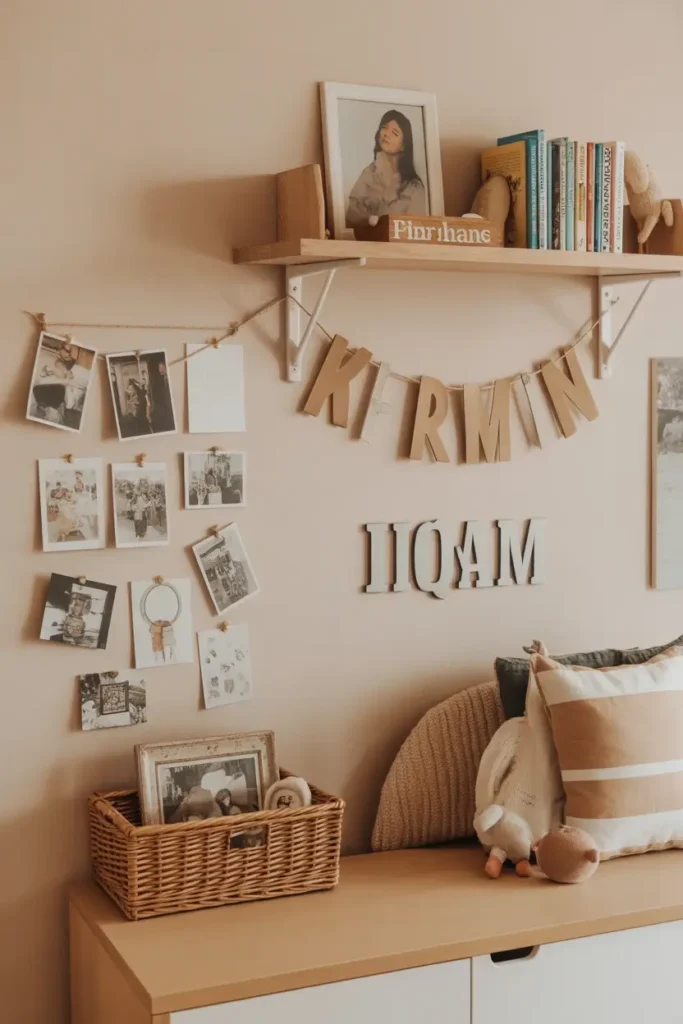
21. Keep the Floor Clear
An open floor instantly makes the room feel bigger. Raised beds and slim tables free up space. Hide cords in covers or baskets for safety.
Skip bulky storage boxes that block walking areas. A clear floor encourages play and movement.
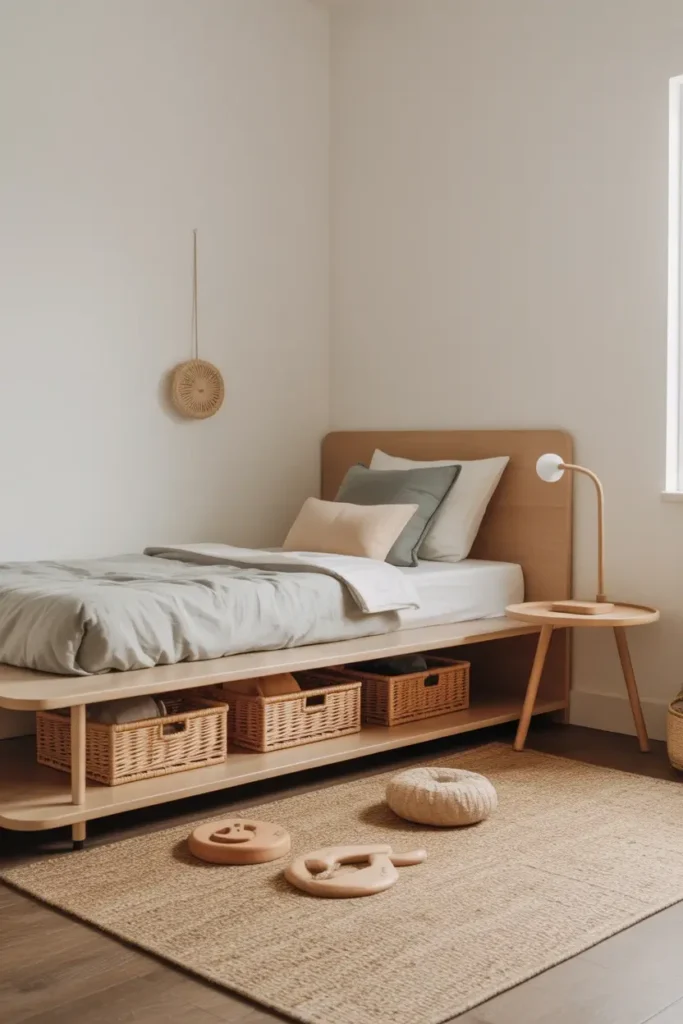
22. Use Mirrors
Mirrors make small rooms brighter and wider. For light reflection, place one across from a window.
A full-length mirror doubles as decor and function. Kids enjoy seeing outfits and dance moves in it. Mirrors create energy while saving space.
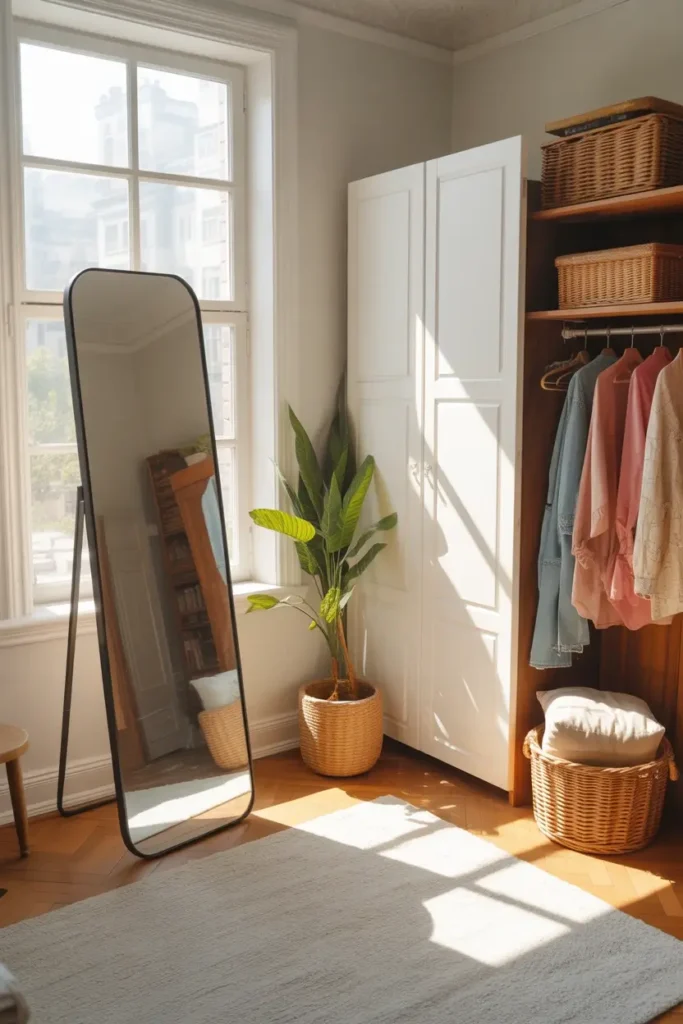
23. Add Colorful Curtains
Curtains bring both style and function. Bright fabrics lift a neutral room instantly. They also block light when kids need rest.
Patterns add charm without much cost. A simple switch of curtains refreshes the whole space.
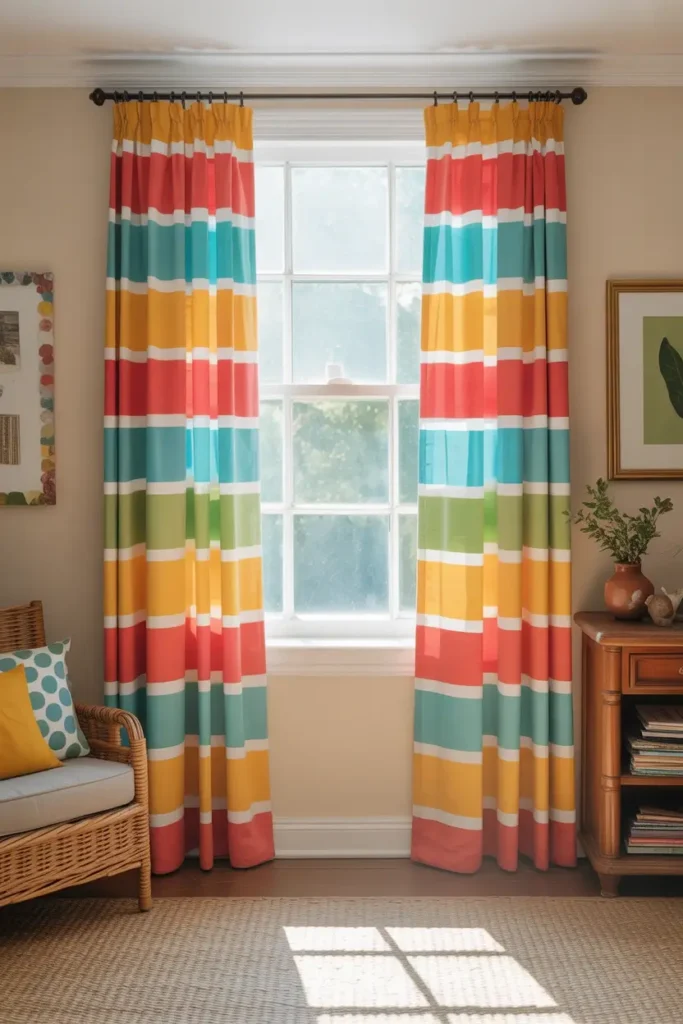
24. Play Zones Inside Rooms
Creating play zones keeps toys under control. A rug or mat can mark the area. Low bins make it easy for kids to tidy up.
Clear borders stop toys from spreading everywhere. The rest of the room stays neat and open.
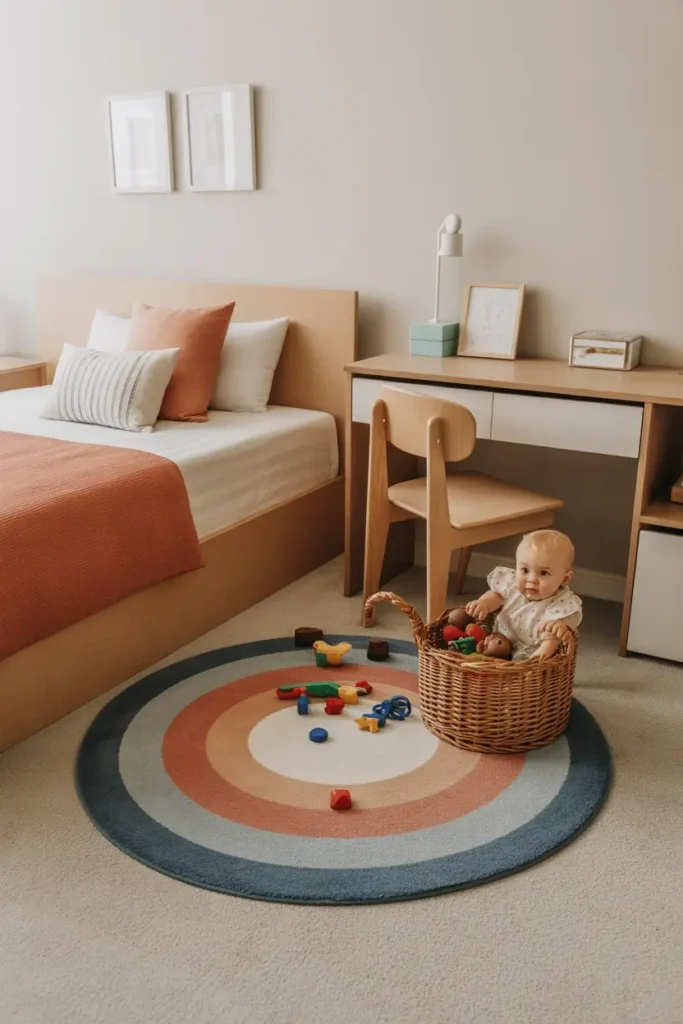
25. Built-In Desk Area
A built-in desk makes study time simple. It saves space compared to stand-alone tables.
Shelves above hold books and school supplies. The area stays organized with clear zones for work. Kids get a place that feels dedicated to focus.
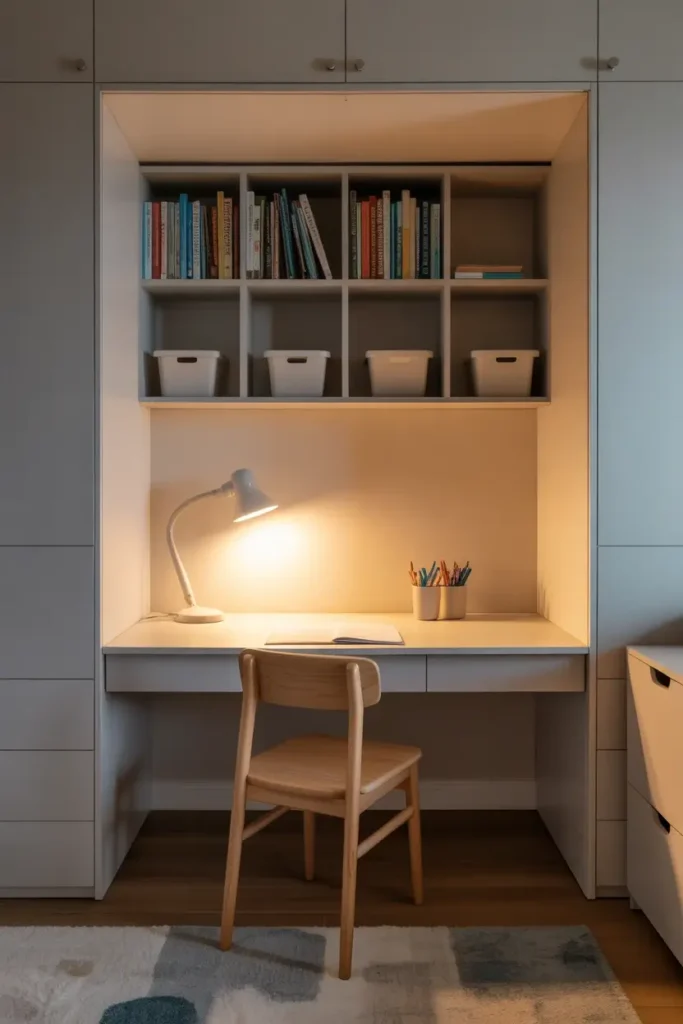
26. Layer Bedding
Layered bedding makes the room feel inviting. A mix of sheets, blankets, and throws adds comfort.
Different textures keep it from looking flat. Bright covers bring color without repainting walls. It’s a quick way to refresh the bedroom.
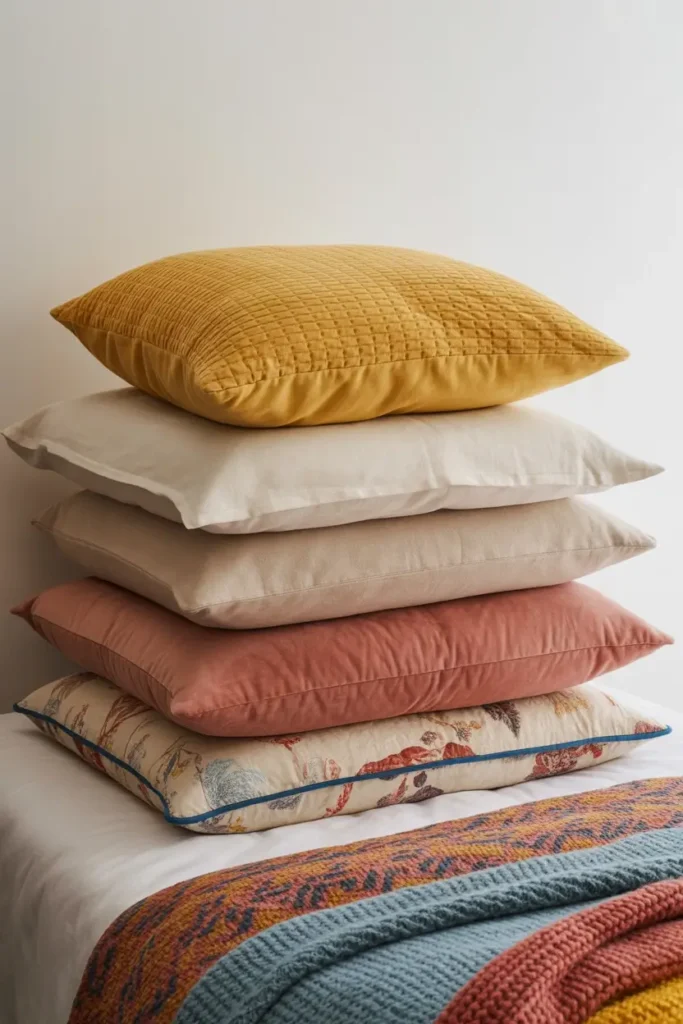
27. Add a Canopy
A canopy turns a bed into a cozy retreat. Sheer fabric creates softness and charm. Kids enjoy the sense of privacy it gives.
It also works as playful decor without clutter. A canopy makes the room feel magical and safe.
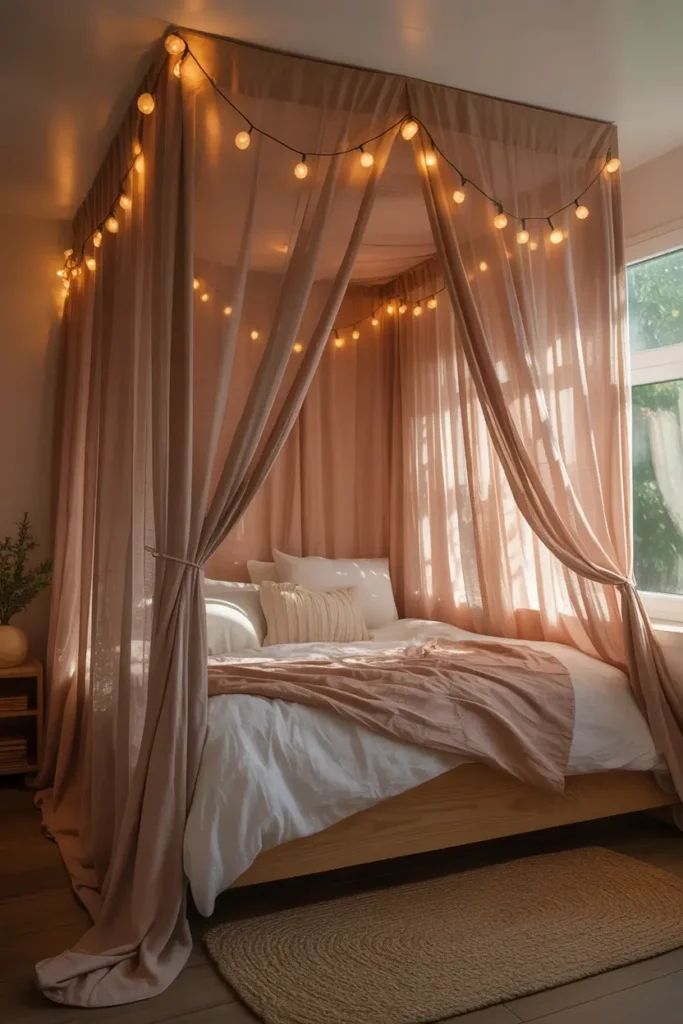
28. Wall Decals for Easy Change
Wall decals let you update the room fast. They peel on and off without damage. Choose animals, stars, or shapes that kids enjoy.
They’re cheaper than wallpaper but still add impact. The design can change easily as tastes grow.
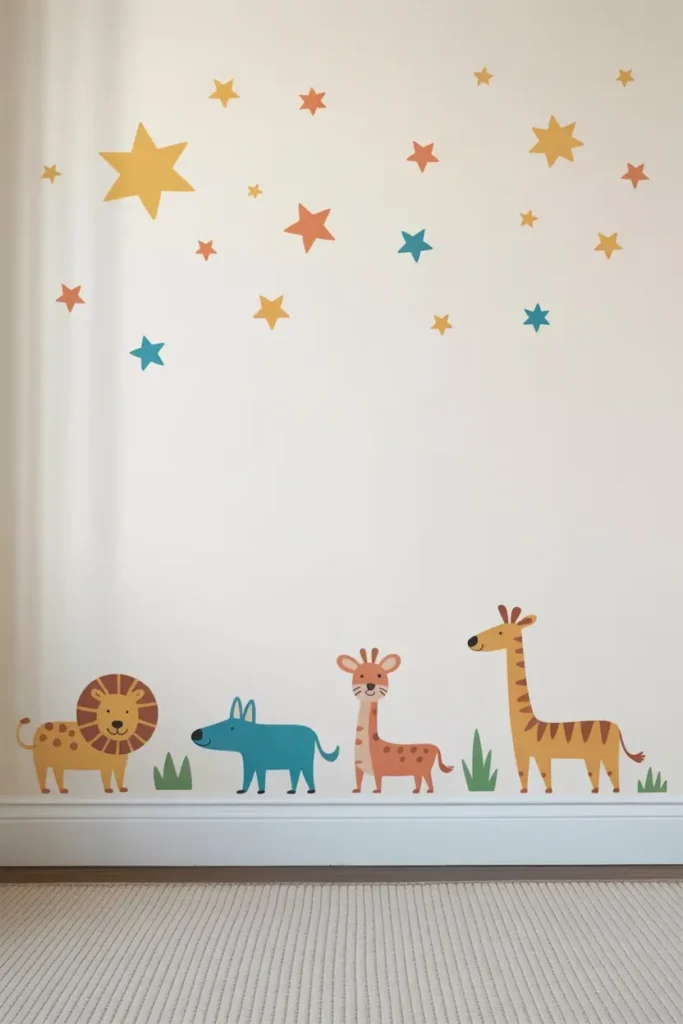
29. Use Multi-Use Furniture
Furniture with multiple purposes saves space. Beds with drawers or ottomans with storage are smart picks. A fold-out desk also works well for study. These pieces cut down on clutter naturally. The room stays open and organized.
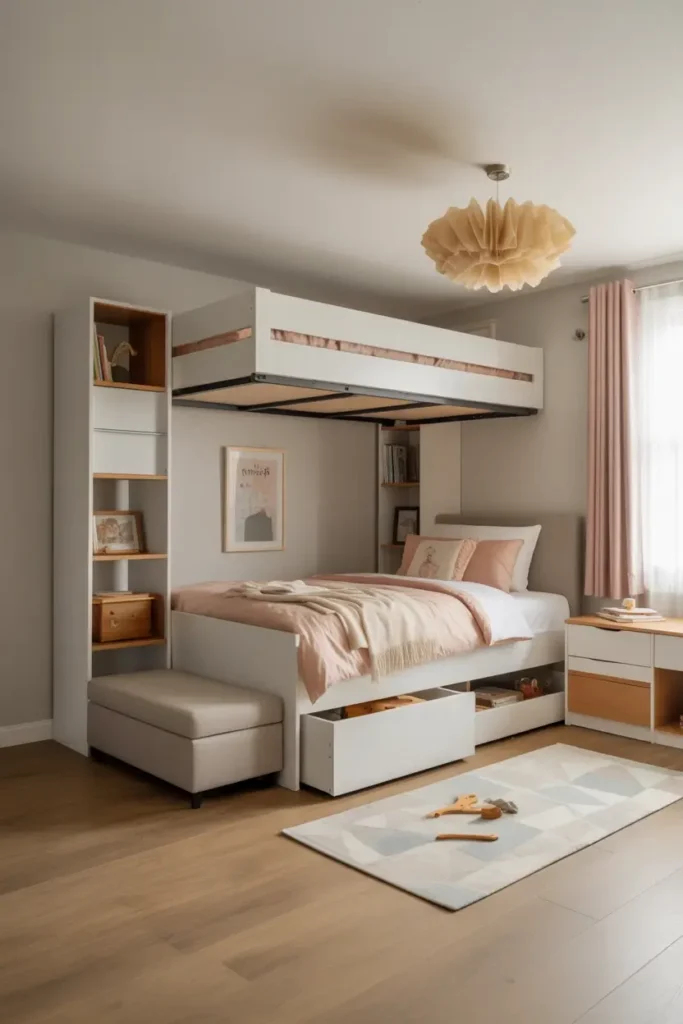
30. Bright Play Rugs
Play rugs double as fun and function. Roads, maps, or hopscotch designs invite activity. They also cushion the floor for safety.
Kids enjoy both play and comfort in one spot. A single rug can transform the play area.
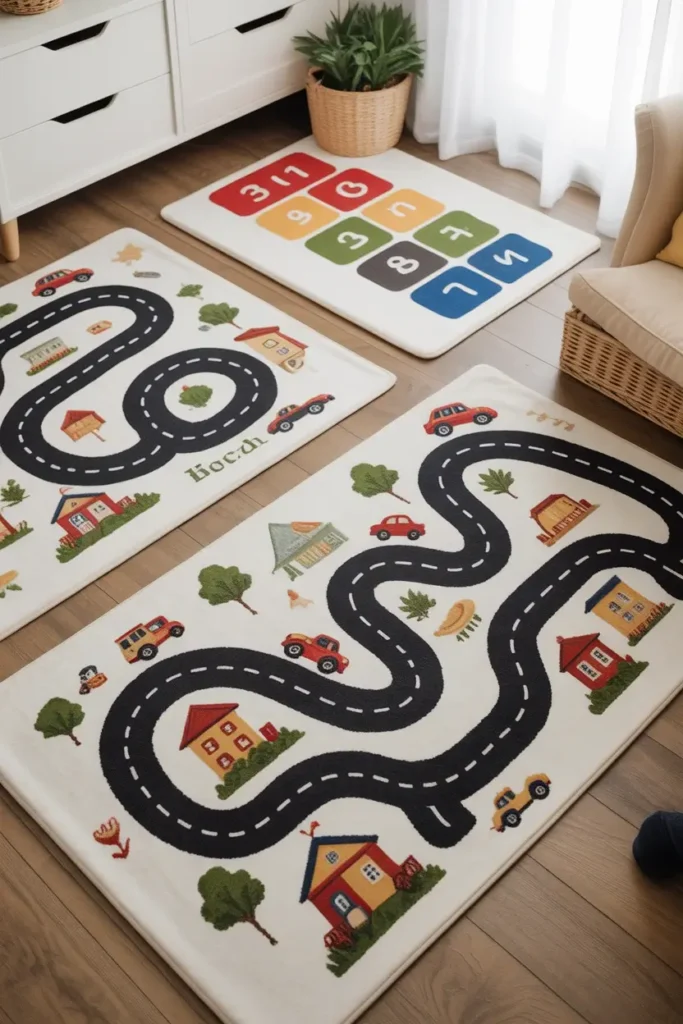
31. Add Open Book Shelves
Open shelves make books easy to spot and grab. They encourage daily reading without reminders.
Bright covers double as cheerful wall decor. Keep shelves low so kids reach them easily. A small reading zone feels natural in the room.
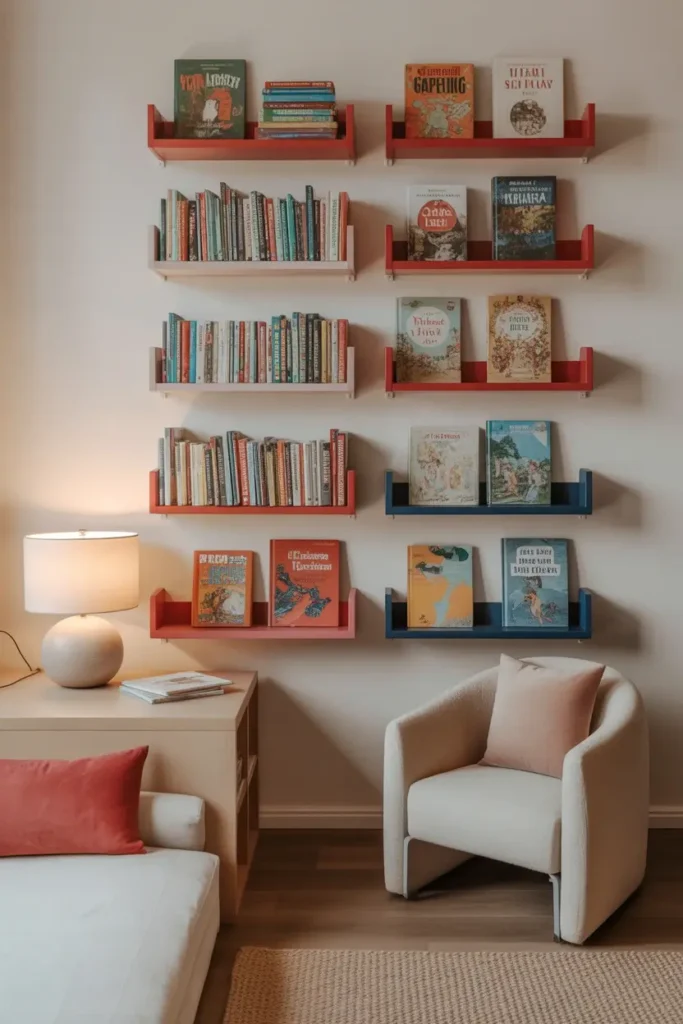
32. Bright Ceiling Lights
A strong ceiling light helps with homework and play. Choose a simple fixture for wide coverage.
Add a dimmer switch for softer evenings. Bright light keeps the room practical and safe. Kids benefit from a well-lit, cheerful space.
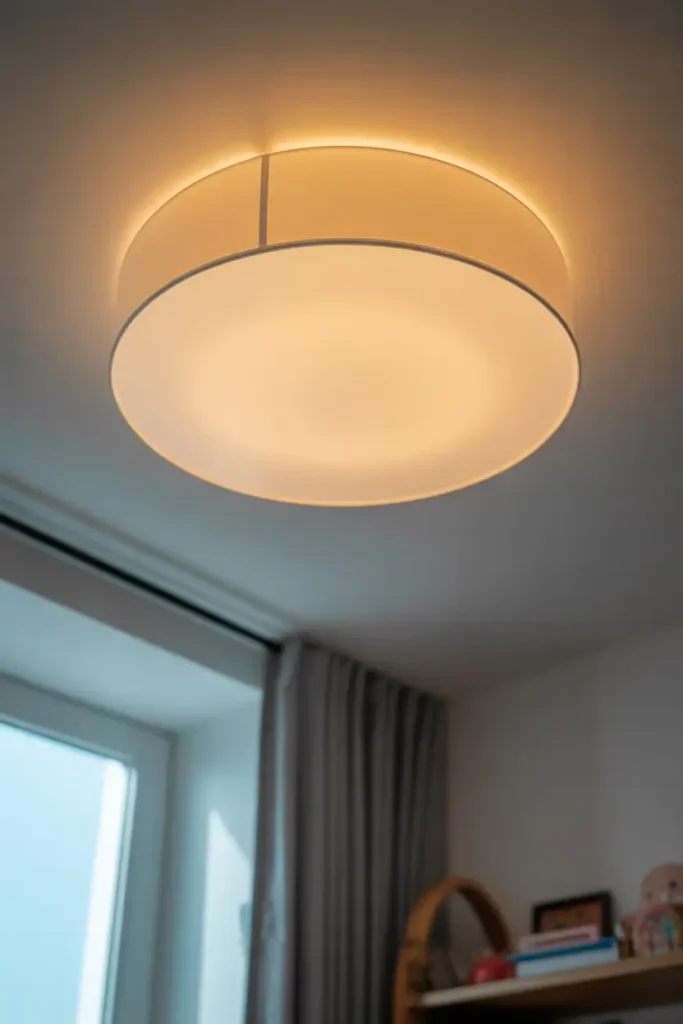
33. Use Wall Hooks
Wall hooks keep jackets, bags, and hats off the floor. They’re simple to install and save closet space. Fun shapes make them part of the design. Kids learn to hang items up quickly. The room stays tidy with little effort.
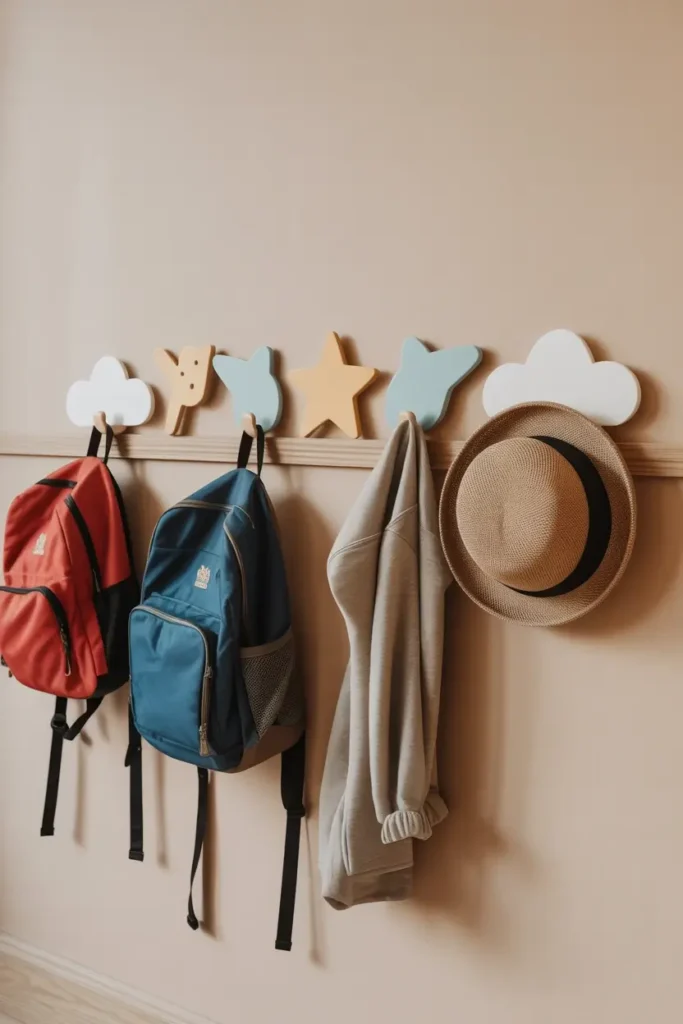
34. Add a Chalkboard Wall
A chalkboard wall brings creativity into the room. Kids can draw, write notes, or practice spelling.
It wipes clean for endless use. One wall or panel is enough for fun. The space becomes both playful and functional.
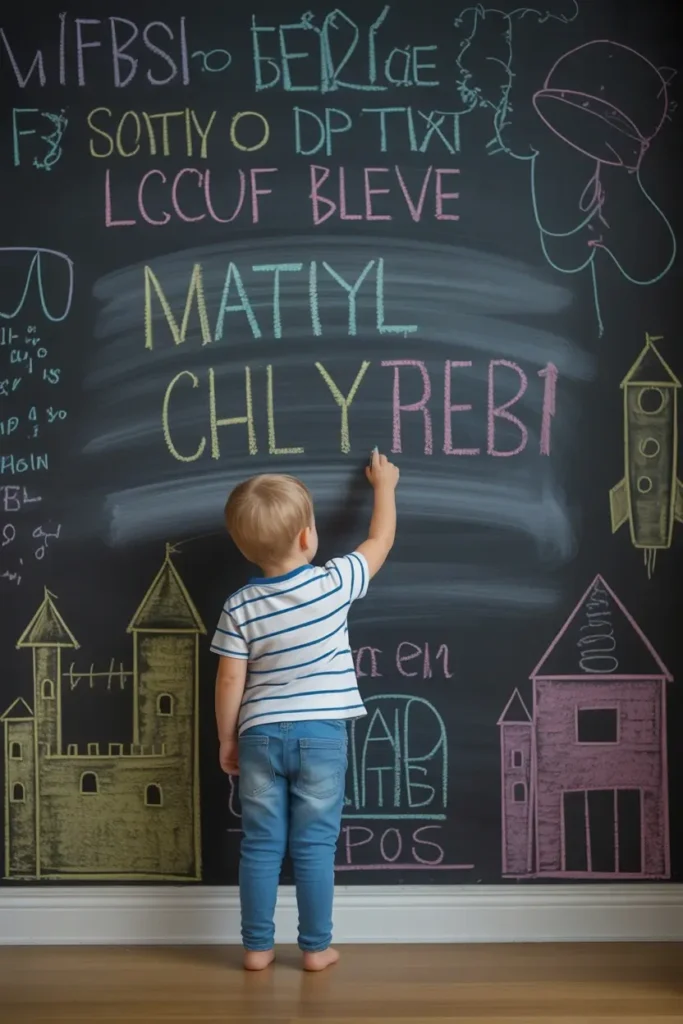
35. Mix Soft Textures
Soft textures make the room cozy and warm. Rugs, cushions, and throws work best in layers.
They soften wood or tile floors instantly. Textiles also add color without painting walls. The space feels inviting for rest and play.
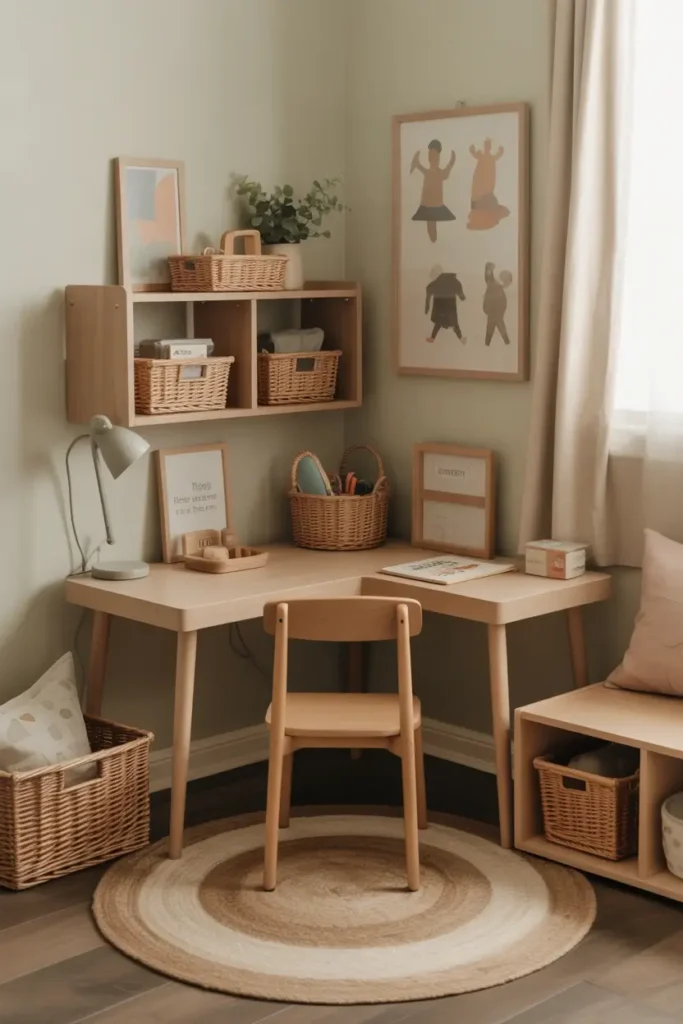
36. Add a Study Nook
A small study nook gives kids a place to focus. A desk, chair, and lamp are enough. Keep supplies nearby for easy access.
Quiet corners work best for fewer distractions. The nook helps separate school time from play.

37. Use Bunk Beds with Storage
Bunk beds with built-in drawers save valuable space. They hold clothes, books, or toys neatly.
Steps with storage add even more function. This design keeps the floor open for play. It’s a smart option for shared rooms.
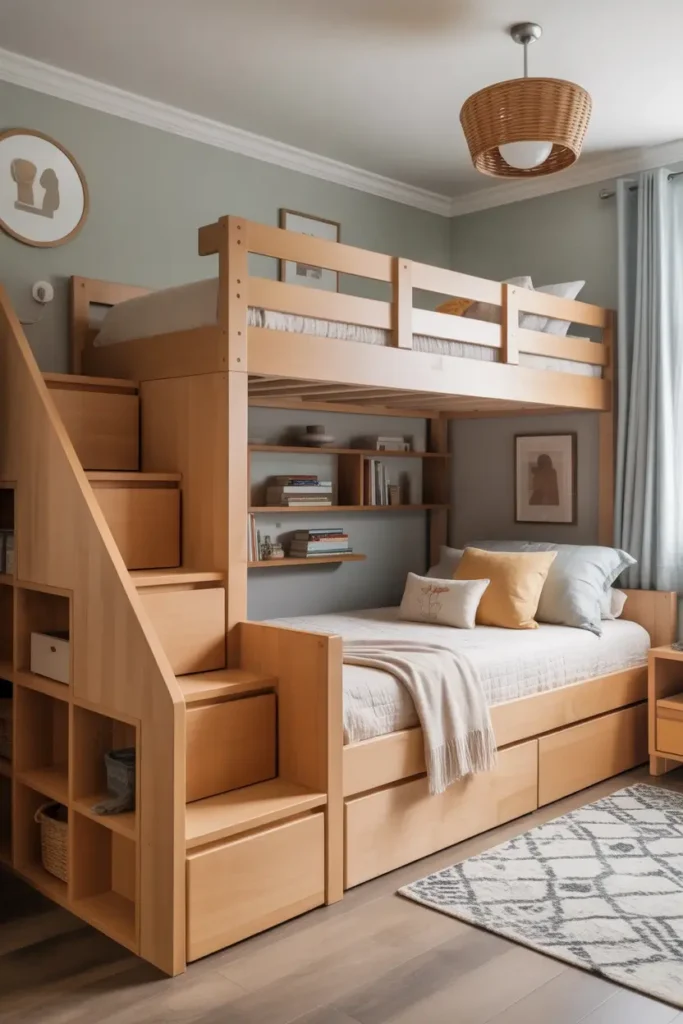
38. Wall Art with Meaning
Art adds personality when it tells a story. Choose pieces that reflect hobbies or favorite themes.
Posters or framed prints make walls come alive. Art is easy to update as kids grow. It brings character without taking up space.
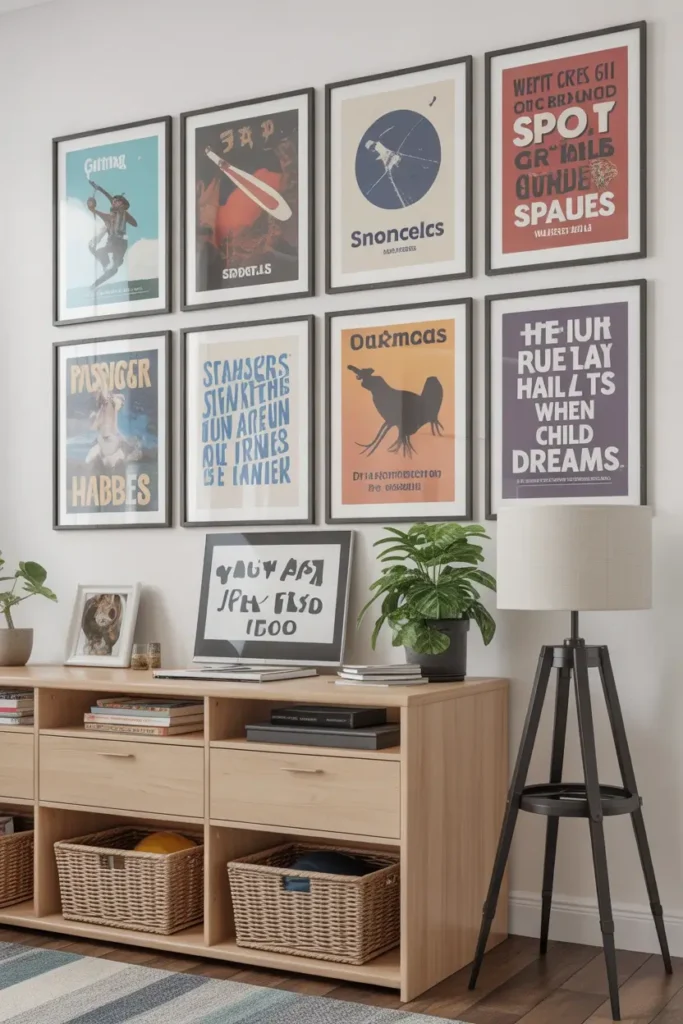
39. Play Tents in Traditional Kids Room Decor
A play tent makes the room more fun and inviting. Kids enjoy having a hideout of their own.
It works for reading, games, or quiet breaks. Tents fold away when space is needed. This small touch adds big excitement.
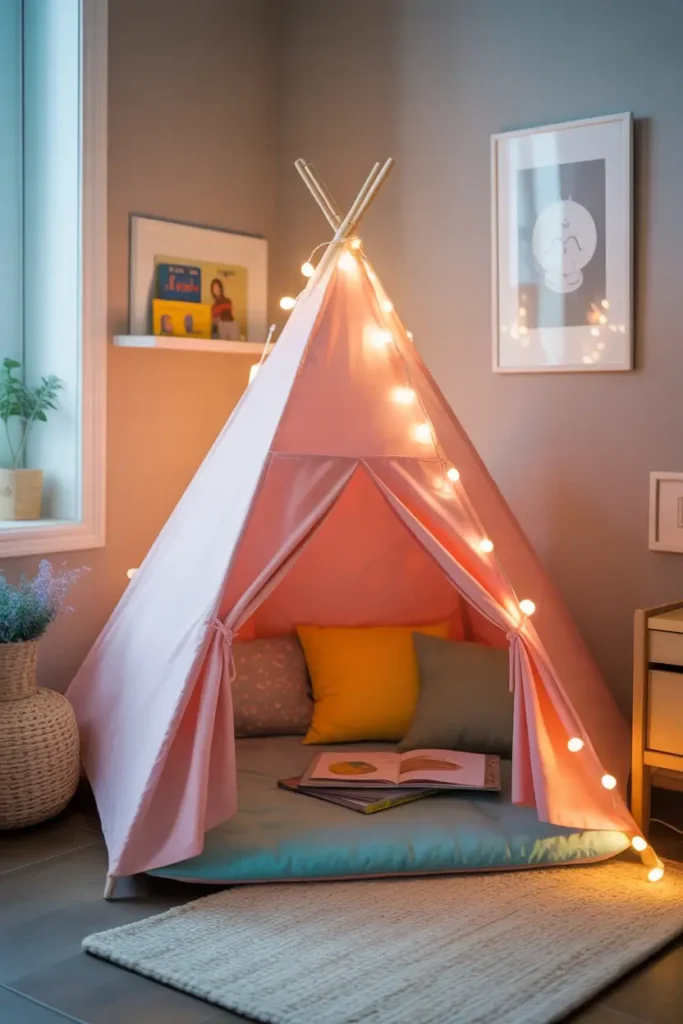
40. Color Block Walls
Color blocking gives walls a bold, modern feel. Two or three shades create a playful divide.
Use tape for clean and simple lines. Bright tones make the room lively and fresh. It’s an easy project with lasting impact.

41. Add Window Seats
Do you know that a window seat makes a cozy reading spot? Cushions and pillows add charm and style.
Storage drawers help to keep trash out of sight. Try some Natural light to make the space bright. It’s both practical and inviting for kids.
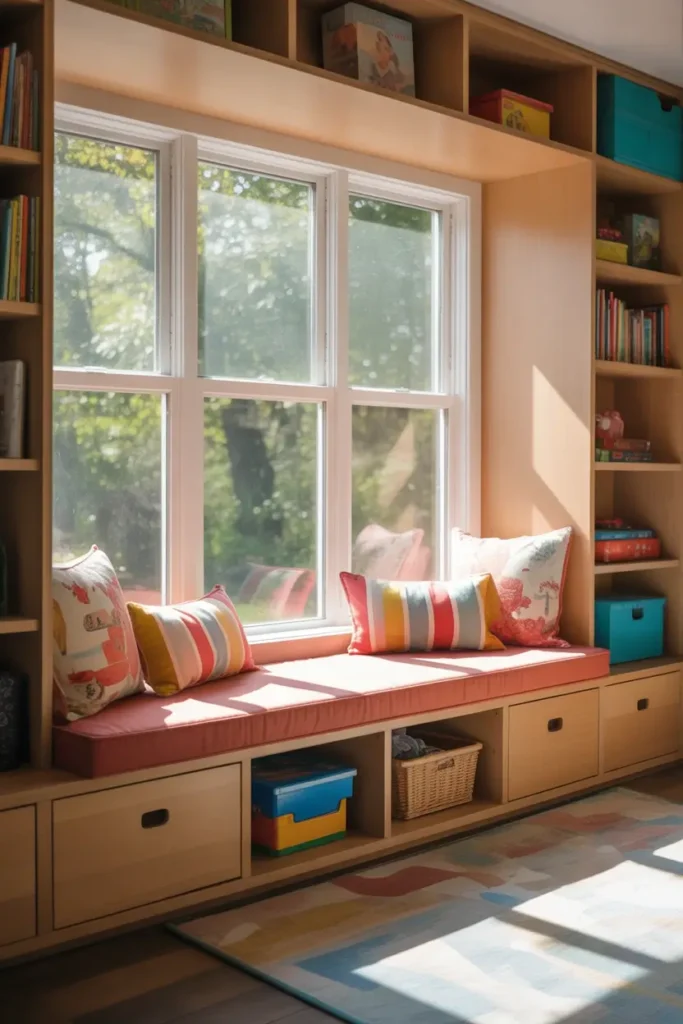
42. Use Striped Walls
Striped walls bring playful energy without too much effort. Vertical stripes make ceilings look higher. Horizontal stripes widen smaller rooms visually. Pick two colors for balance and simplicity. Stripes give walls a fun, modern edge.
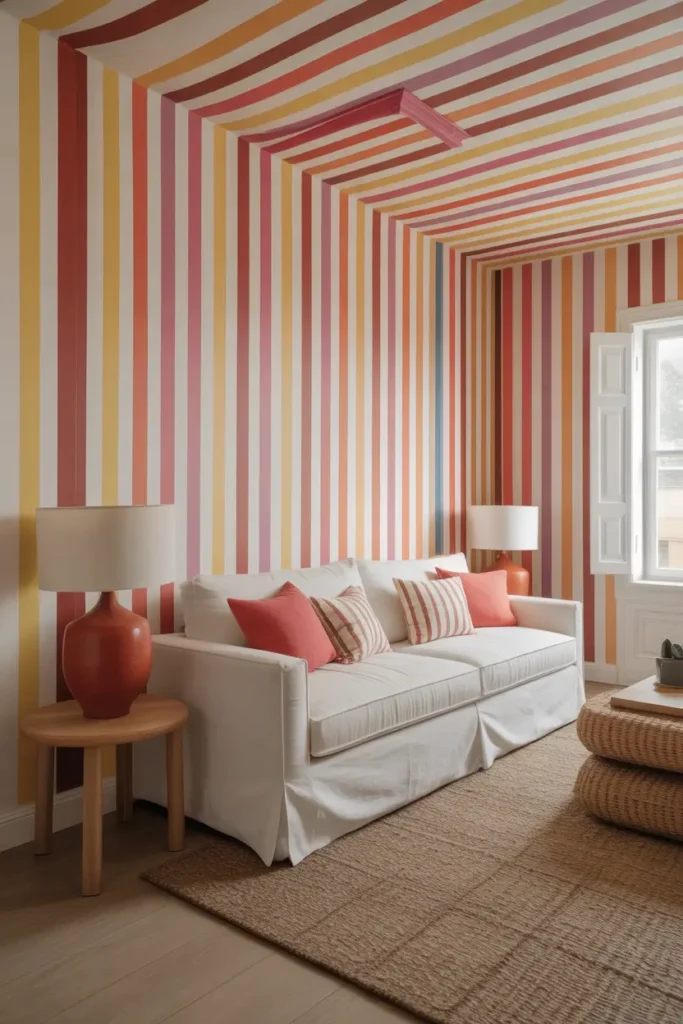
43. Floating Shelves for Decor
Floating shelves hold toys, books, or art neatly. They keep the floor clear and organized.
Simple designs blend well with any style. Kids enjoy seeing their favorite things on display. Shelves grow with the room’s changing needs.
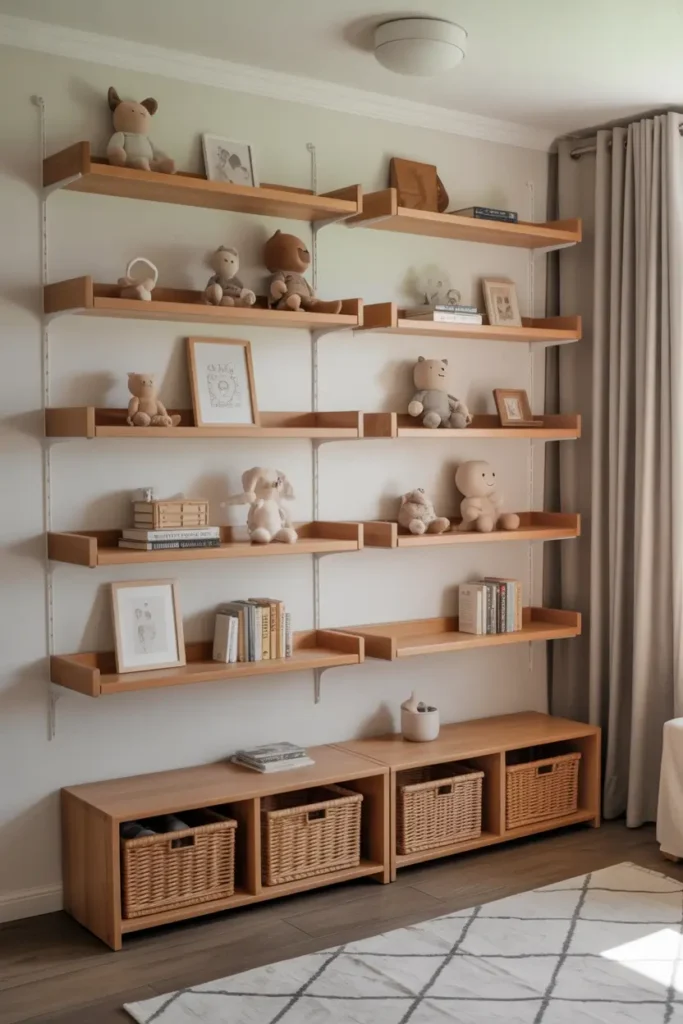
44. Add a Soft Corner
A soft corner creates a safe space for kids to relax. Layer cushions, beanbags, and plush rugs together. It works for play, reading, or naps. The corner feels inviting while staying simple. Soft textures bring comfort to the whole room.
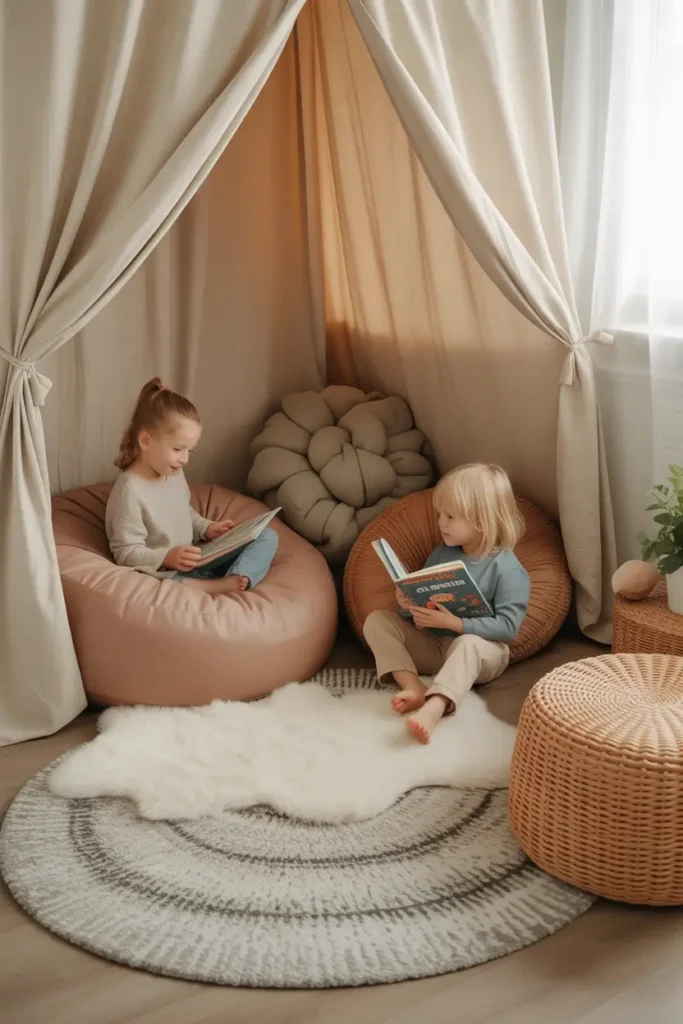
45. Two-Tone Walls
Two-tone walls give depth without needing bold patterns. Light on top and dark below works best.
This setup also hides marks from daily use. Neutral tones pair well with colorful decor. The look is clean, balanced, and kid-friendly.
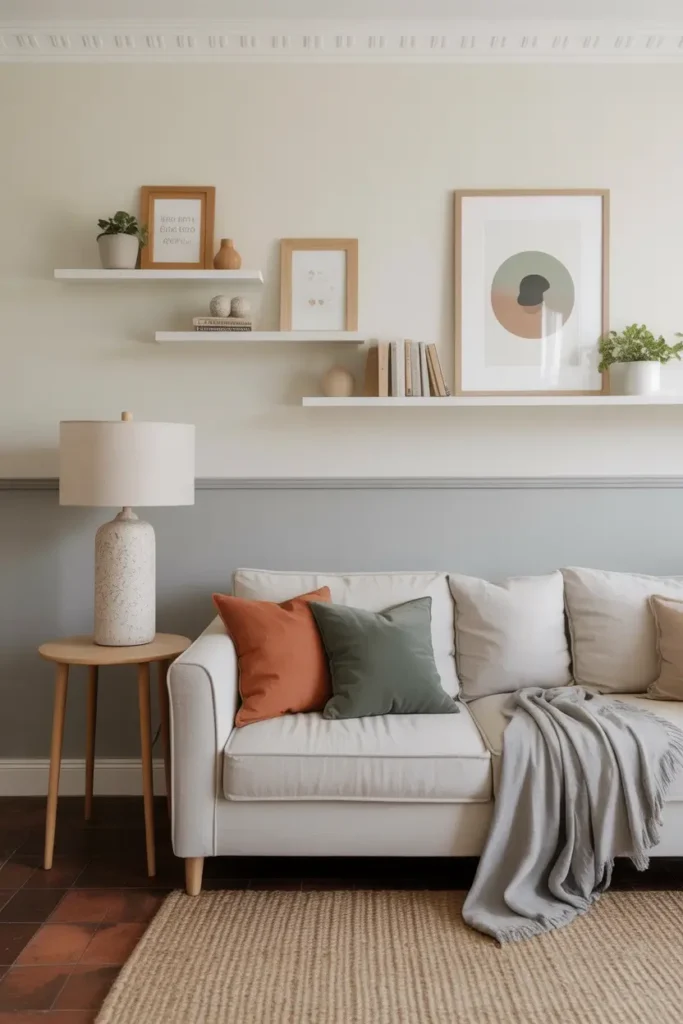
46. Add a Theme Wall
A theme wall gives the room a clear identity. Choose maps, stars, or favorite animals for impact.
Keep other walls simple to balance the look. Kids enjoy having one bold spot in their room. It’s easy to change as tastes shift.
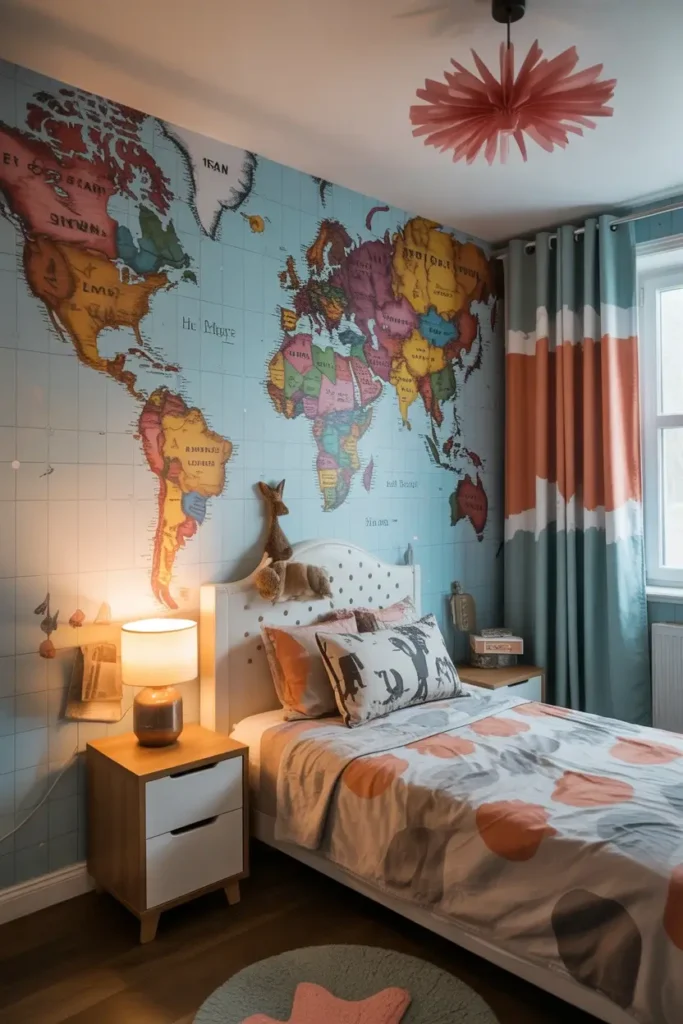
47. Use Under-Bed Storage
Under-bed storage keeps toys and clothes hidden but close. Drawers or bins slide out smoothly when needed.
This saves space and reduces clutter in small rooms. Kids can reach items without much effort. It’s a smart way to stay organized.
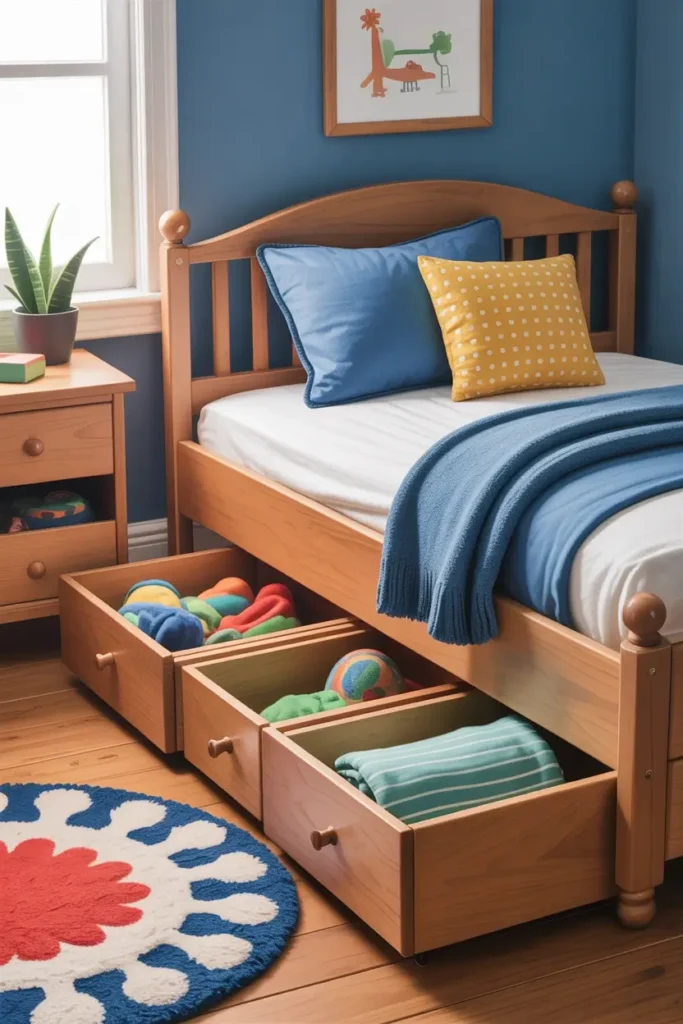
48. Add Fun Chairs
Small chairs make the room more playful and personal. Beanbags or rocking chairs work for reading or games.
Bright fabrics double as decor while staying comfy. Chairs give kids their own seating outside the bed. A fun seat makes the room inviting.
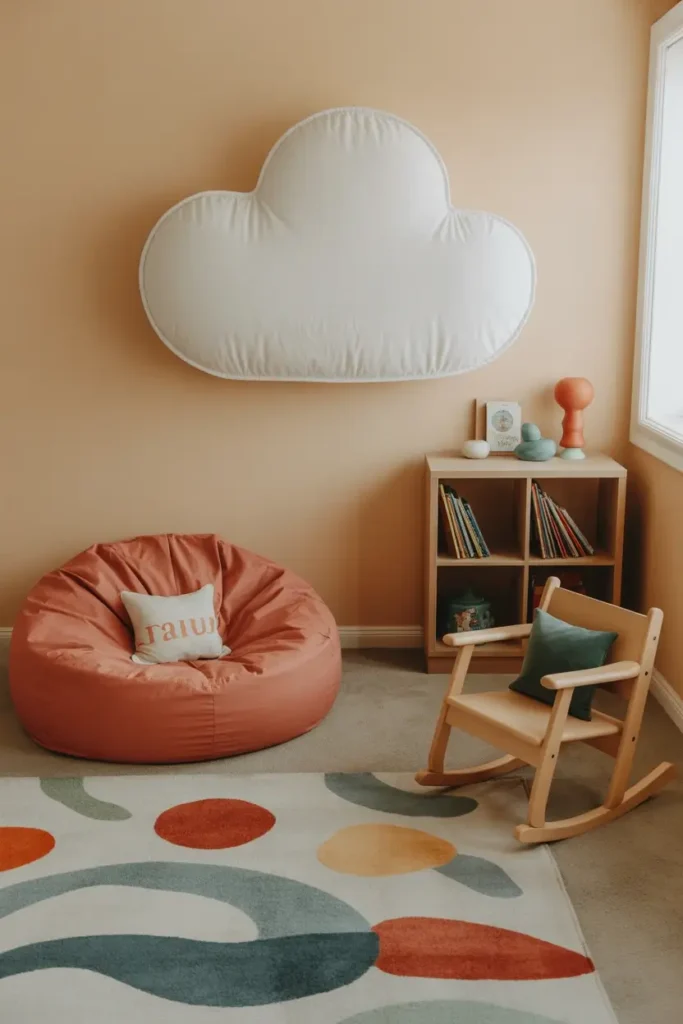
49. Try Layered Lighting
Layered lighting lets kids adjust brightness easily. Ceiling lights, lamps, and nightlights each serve a purpose.
Bright light works for study, while soft light calms evenings. Switching between them keeps the mood flexible. Lighting changes the space with little effort.
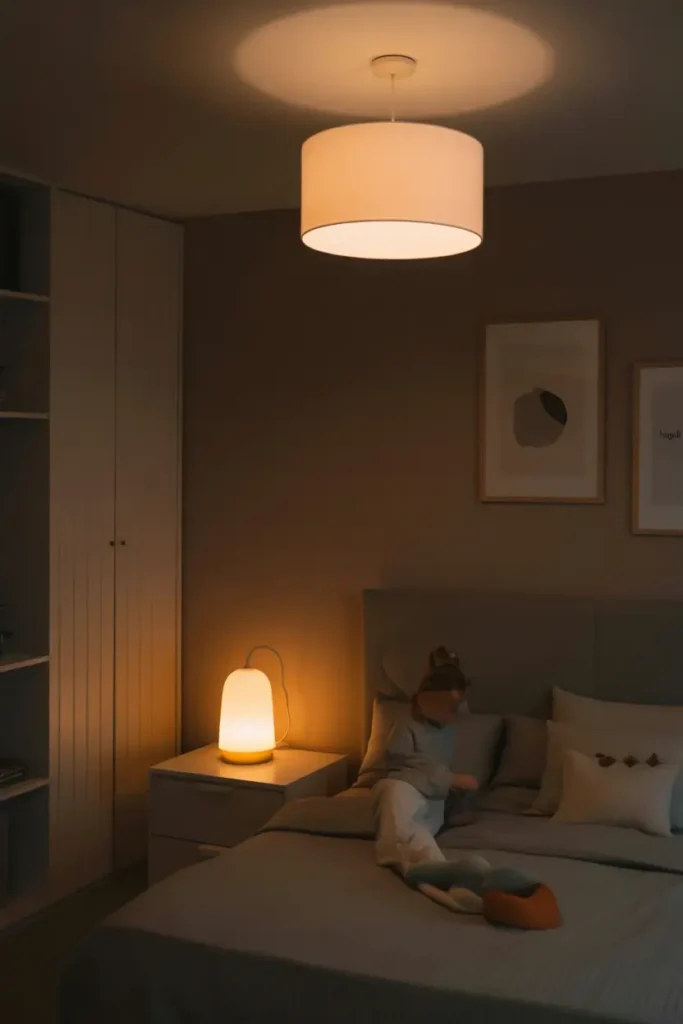
50. Use Open Shelves
Open shelves keep books and toys in clear view. Kids grab what they need without help.
Baskets or boxes make storage neater and safer. Shelves also show favorite items as decor. The setup stays useful as kids grow older.
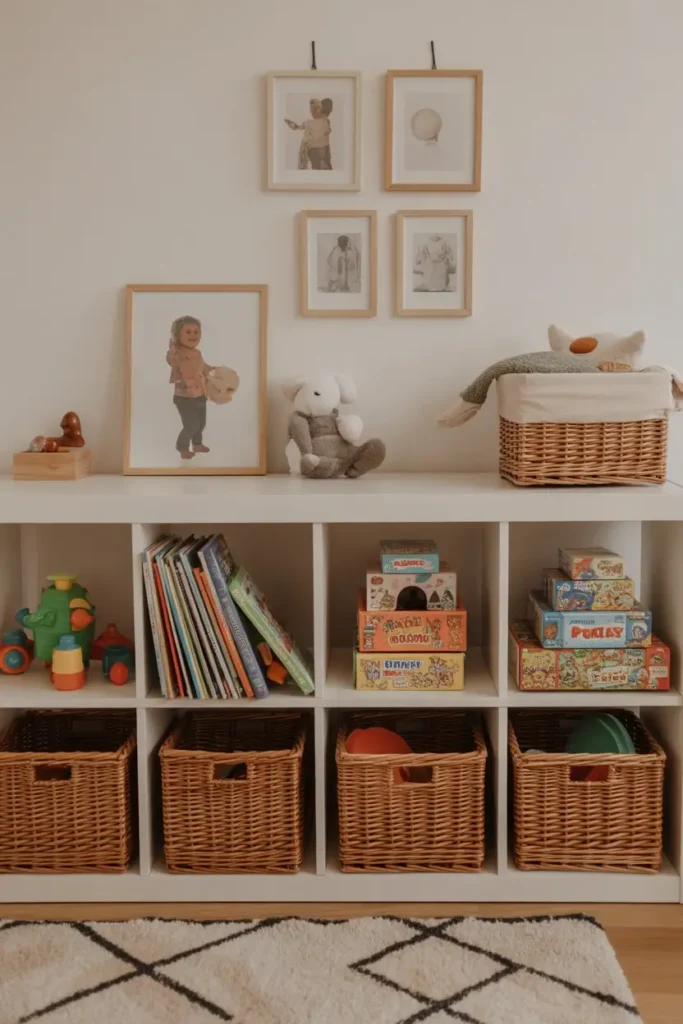
51. Add a Loft Bed
A loft bed frees space for play or study underneath. The raised design makes the room feel bigger.
A desk or sofa fits neatly below the bed. Kids enjoy climbing up to their own cozy nook. It’s both practical and fun for small rooms.
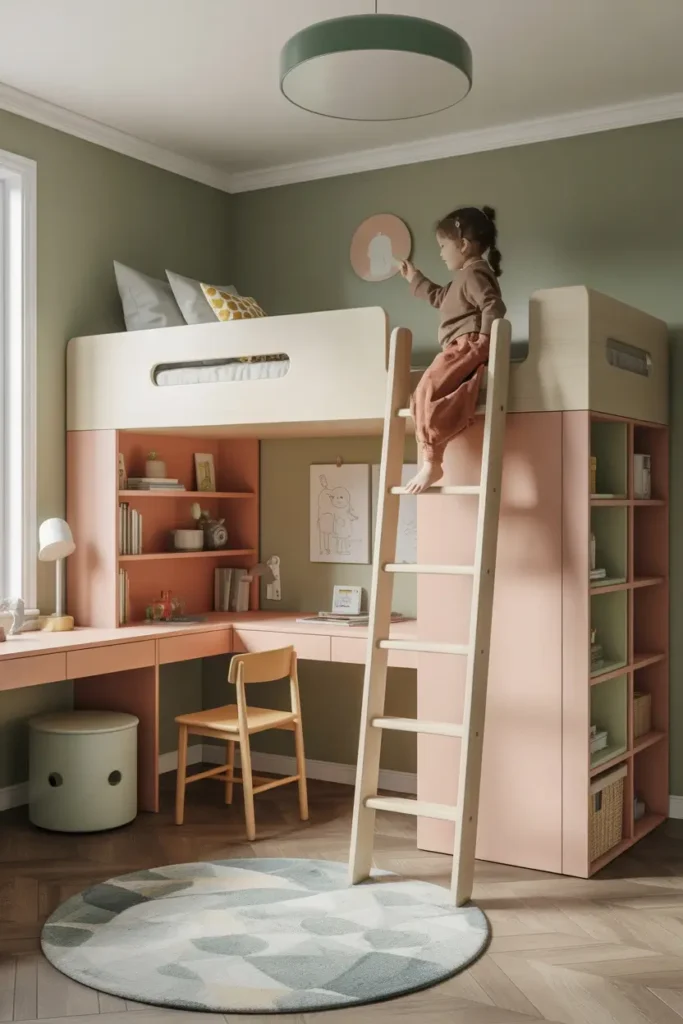
52. Try a Color-Drench Look
Color drenching makes a bold, stylish statement. Paint walls, ceiling, and trim in one shade.
Add lighter or darker accents for depth. The room feels fresh and put together. It’s a simple way to create strong visual impact.
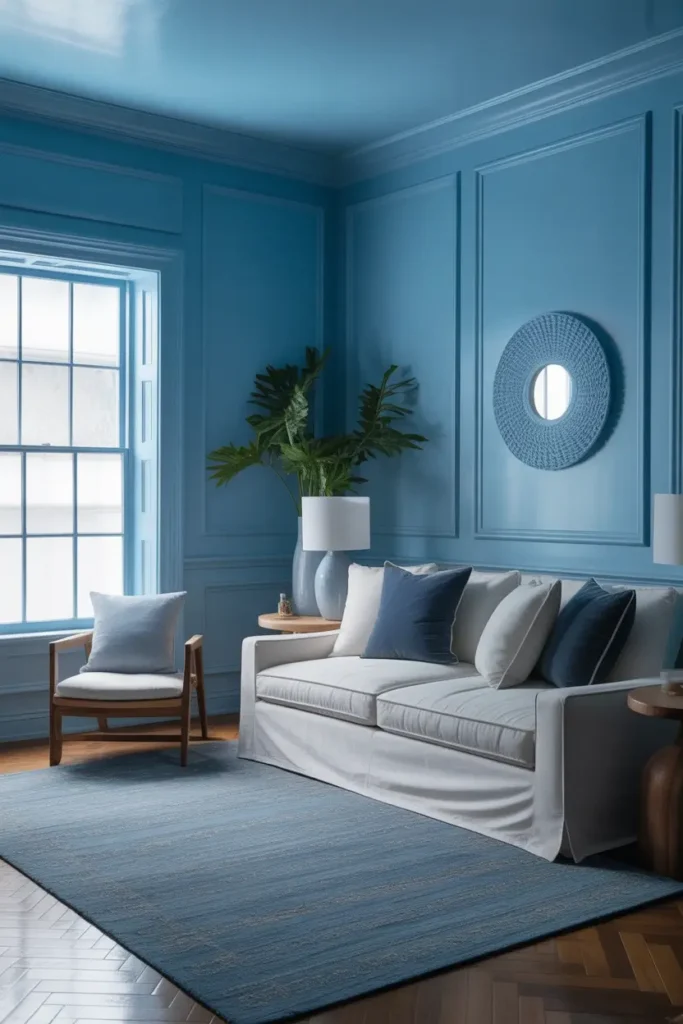
53. Use Sliding Doors
Sliding doors save space compared to swinging ones. They work well for closets or shared rooms.
Panels can be painted or mirrored for style. Kids handle them easily without blocking pathways. The design keeps storage accessible and neat.
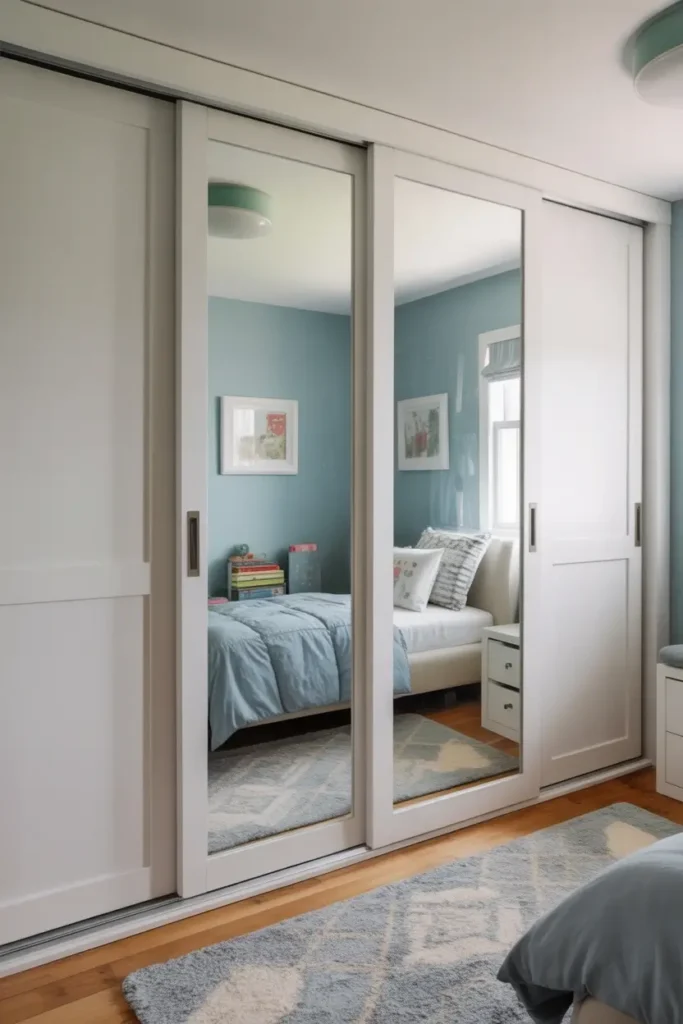
54. Create a Music Corner
A music corner sparks creativity and focus. Add a keyboard, guitar stand, or small drum.
Hooks keep headphones and instruments organized. The setup encourages kids to practice daily. Music blends into the room naturally without taking over.
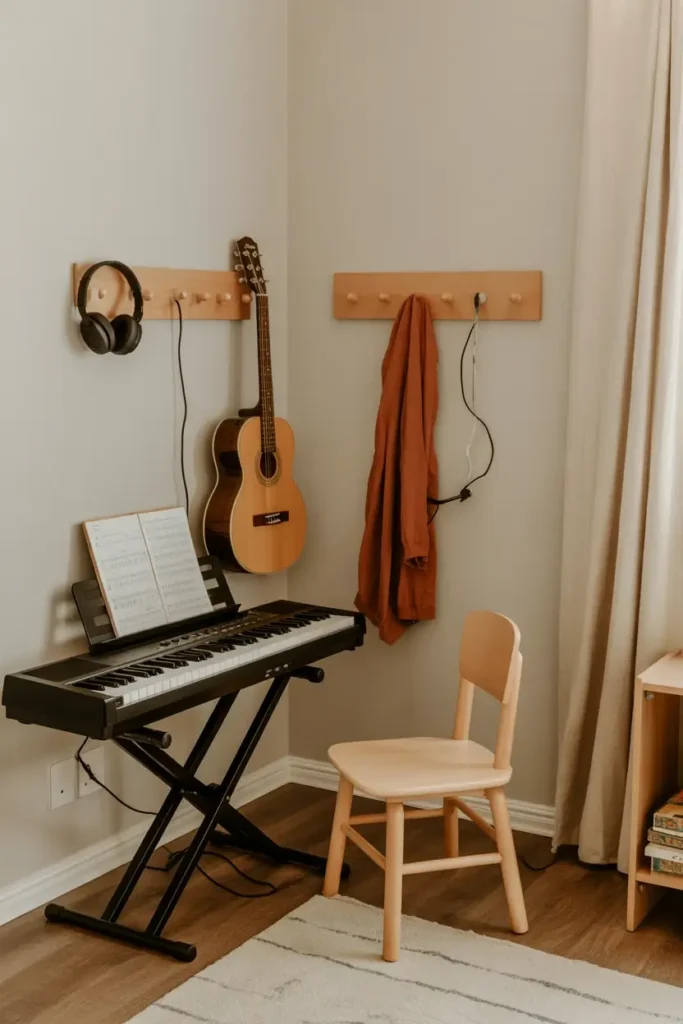
55. Choose Flexible Furniture
Flexible furniture can be used for many purposes. Stackable chairs, foldable tables, or extendable beds work best and cover less space.
These pieces save space while staying useful long-term. They also cut down on constant replacements. The room adapts without major changes.
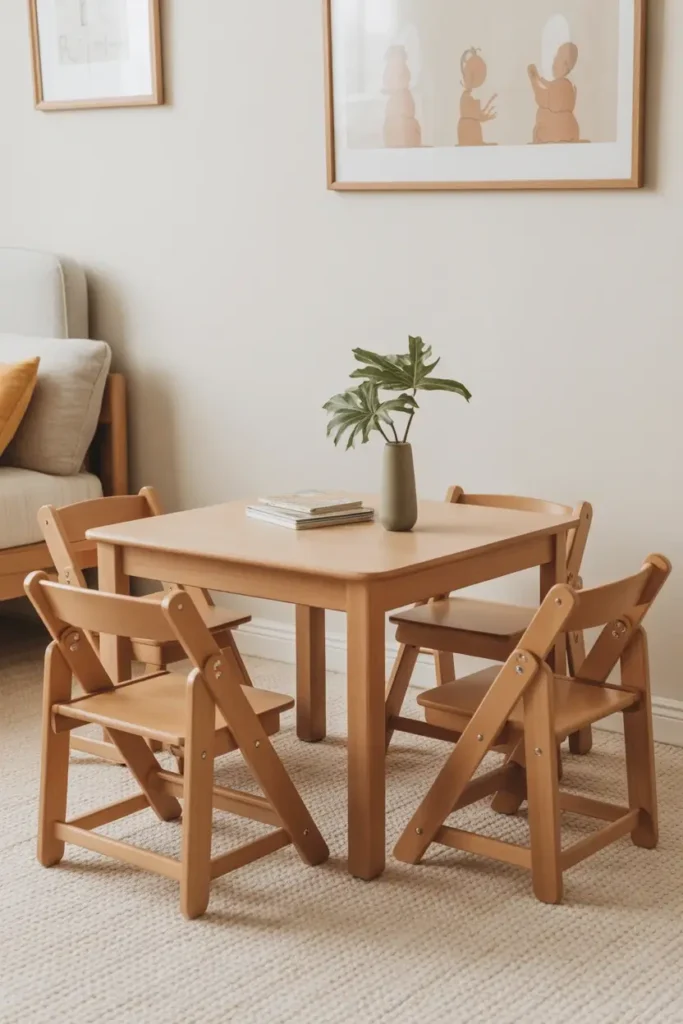
56. Hang a Chalkboard Wall
Kids show their creativity with a chalkboard. Drawings, notes, or homework can be easily managed with it.
The surface looks clean. Frames or borders make it look neat. It doubles as decor and a learning tool.
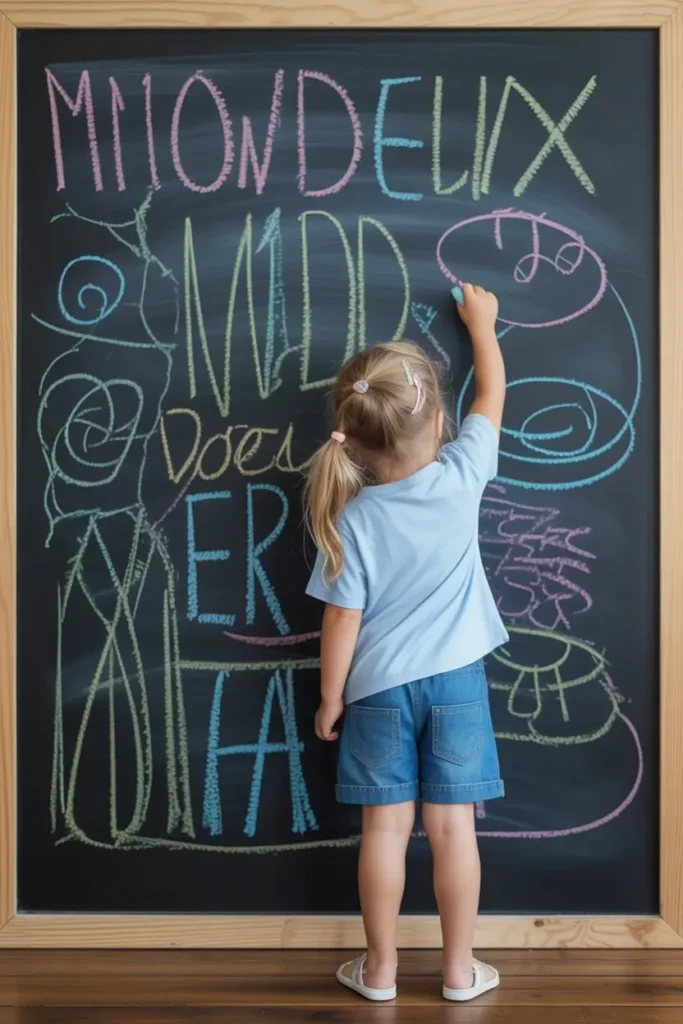
57. Pick Statement Lighting
Lighting sets the mood in any bedroom. A bold pendant, string lights, or neon sign adds charm.
Kids notice the playful glow instantly. It also makes bedtime routines more calming. Statement lighting is both stylish and functional.
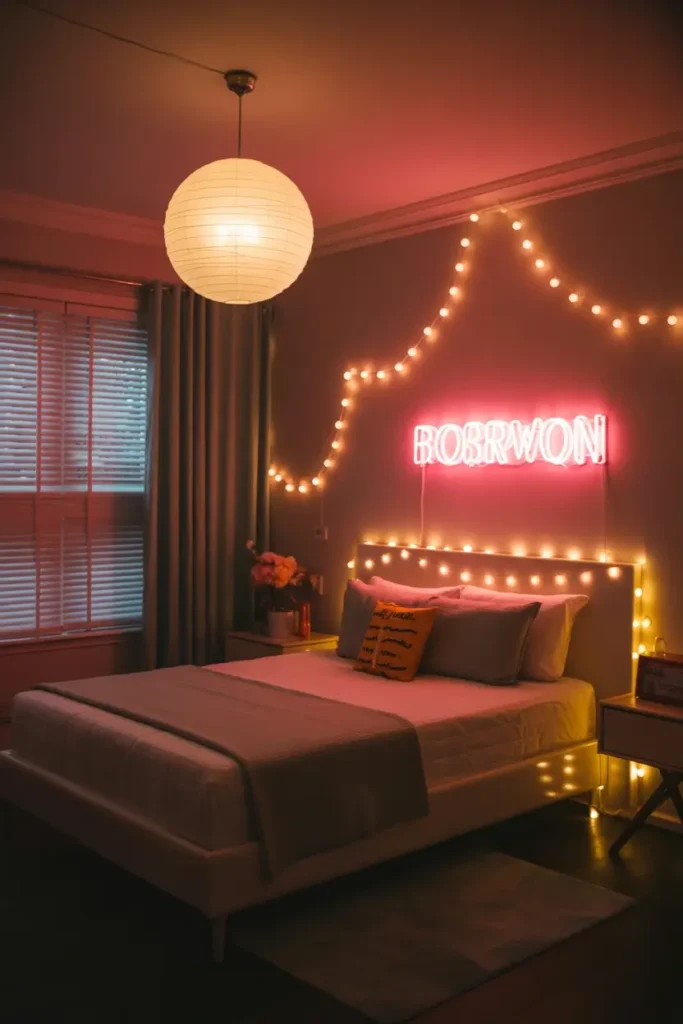
58. Add Window Seating
A window seat creates a quiet corner. This is perfect for reading. Some time for resting alone. Cushions and pillows add comfort and color. Storage drawers below hold toys or books. The spot becomes a favorite in the room.
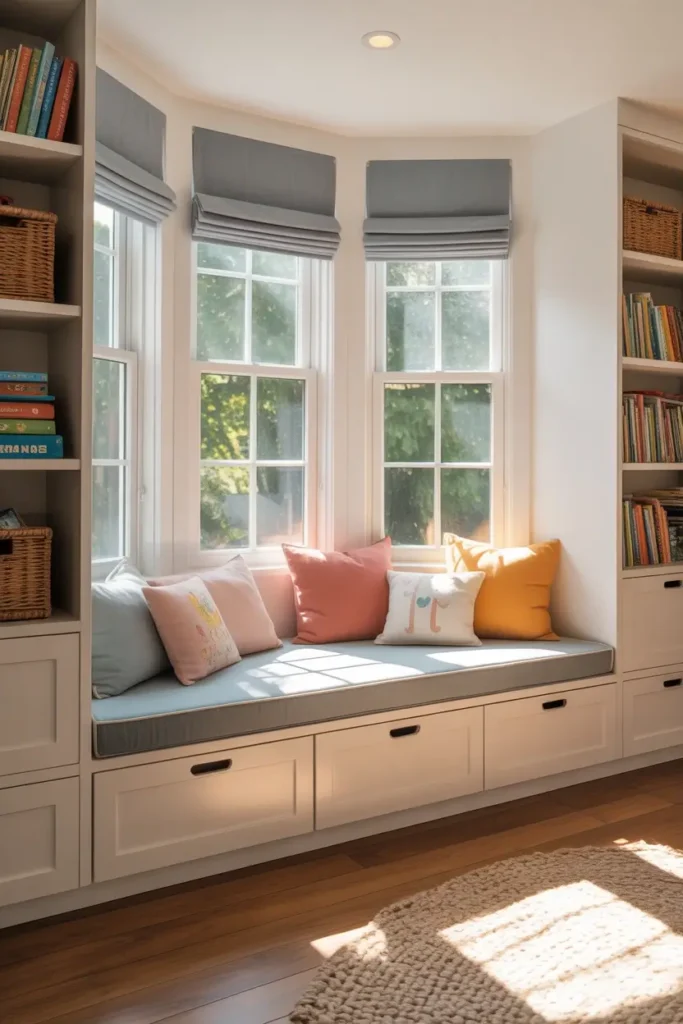
59. Use Open Shelving
Open shelves keep items within easy reach. Toys, books, or art supplies look tidy here.
Arrange them by size or color for style. The design encourages kids to clean up faster. It also shows off favorite collections proudly.
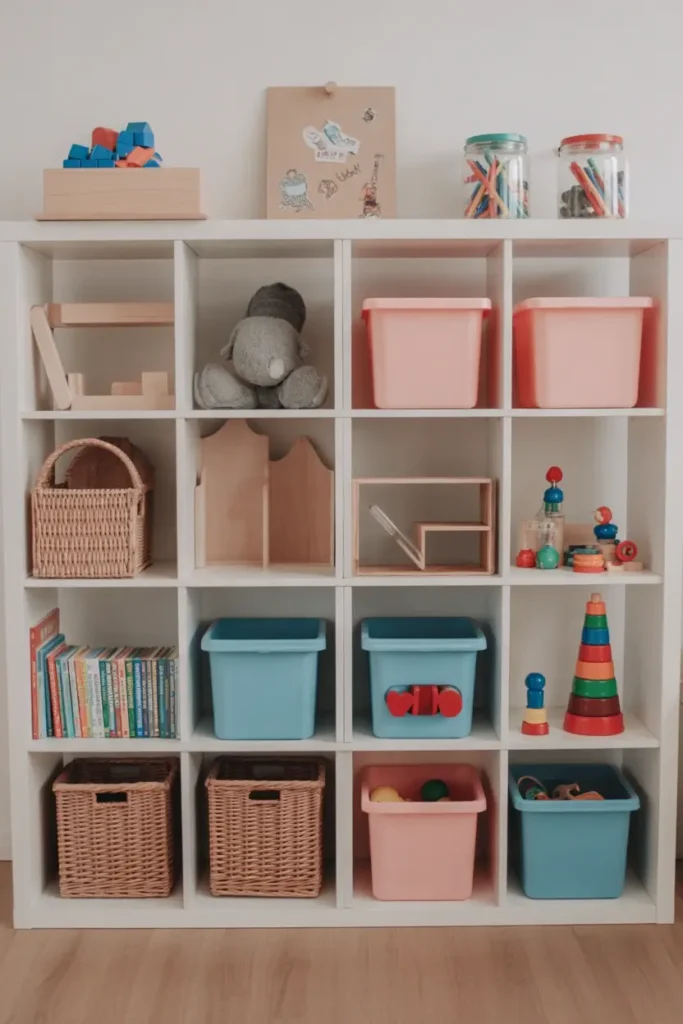
60. Make a Theme Wall
One wall can highlight a theme kids love. Maps, murals, or decals bring it to life. The focus stays simple without overwhelming the room. T
hemes can shift as interests change. It’s an easy way to refresh style.
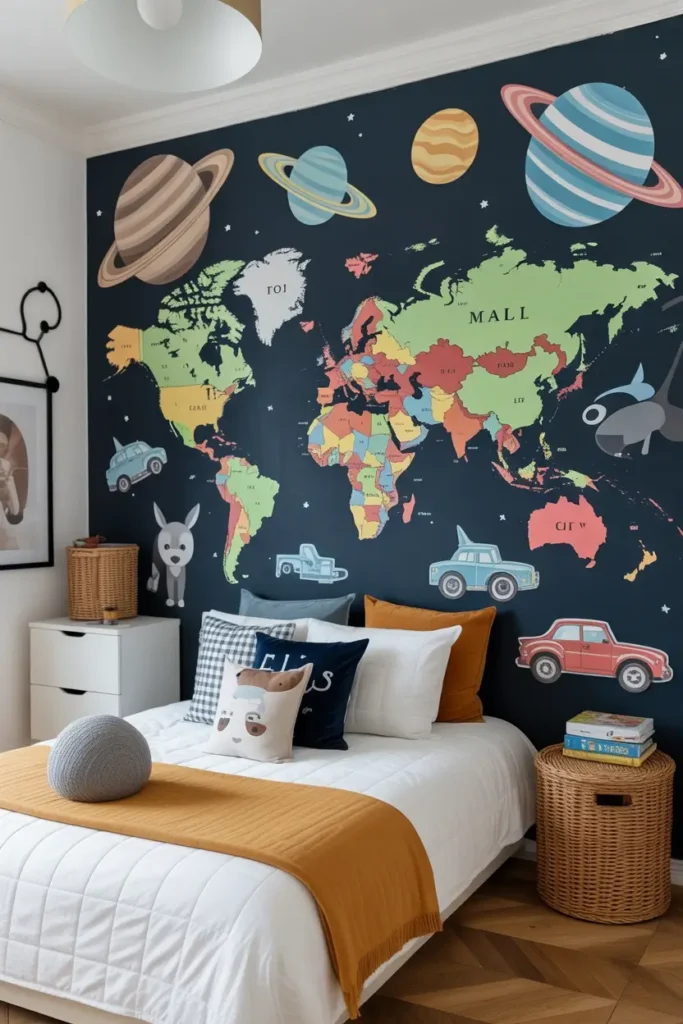
61. Build a Tent Corner
A small tent makes the room feel playful. Kids use it for reading or quiet breaks. Add blankets, cushions, and fairy lights inside. It becomes their own private retreat. The space feels cozy without taking up much room.
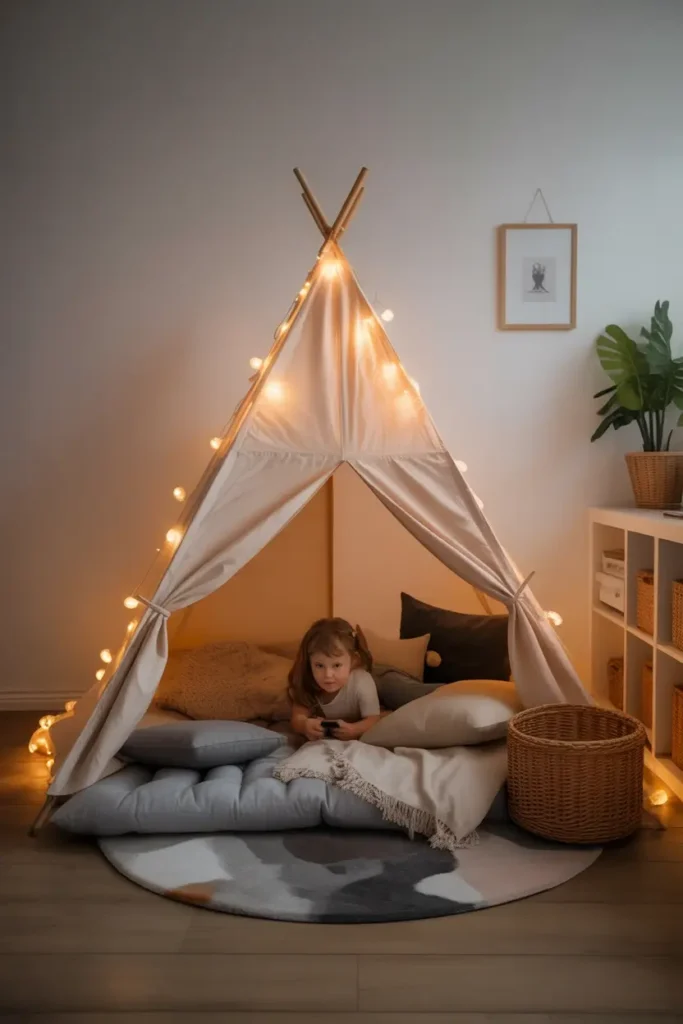
62. Add a Pinboard Wall
Pinboards let kids display artwork, photos, or notes. The wall changes easily as they grow. Use cork, fabric, or magnetic boards for variety. It keeps papers off desks and floors. The setup is both useful and creative.
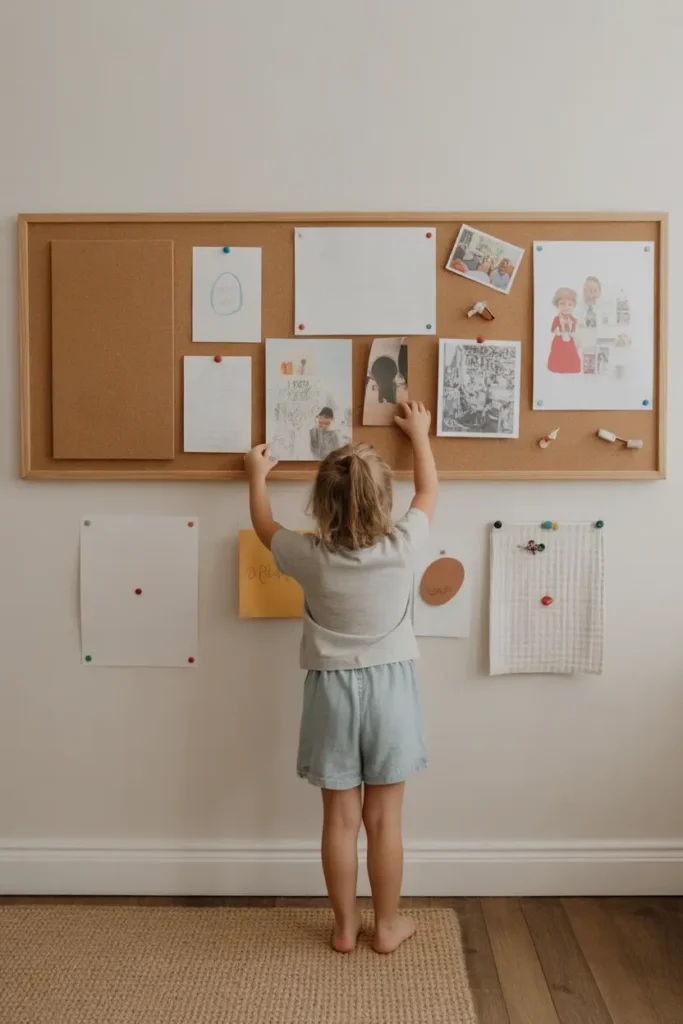
63. Layer Different Rugs
Rugs add warmth and color instantly. Layering two or more creates texture and fun. Use bold patterns with soft neutrals for balance. Kids enjoy sitting and playing on them. Rugs also protect floors from daily wear.
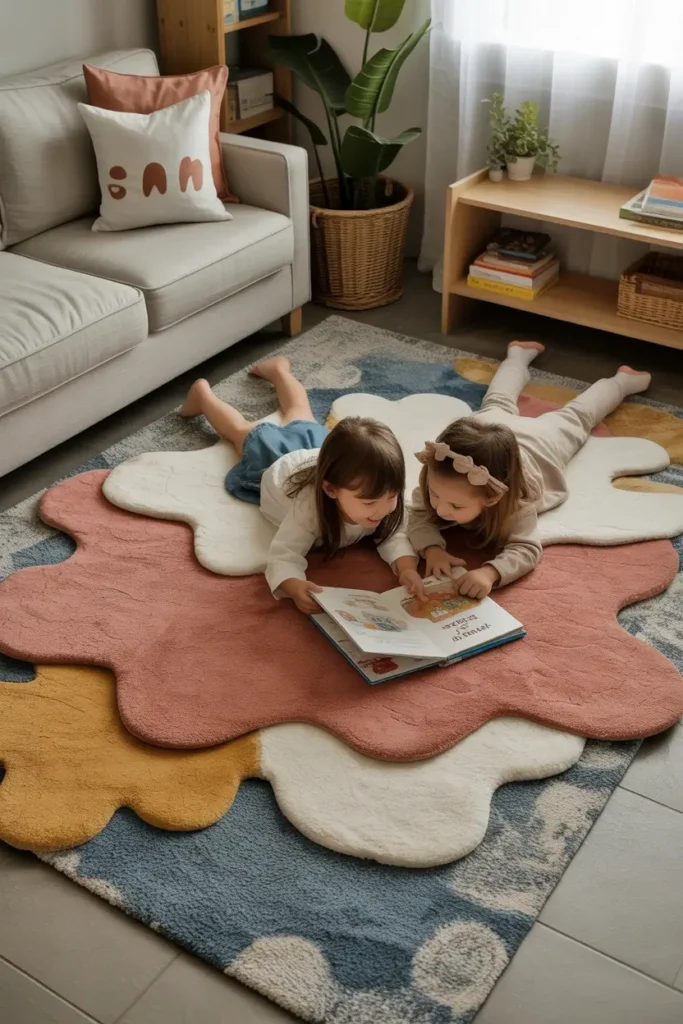
64. Try Hanging Chairs
A hanging chair brings energy to the room. It doubles as a relaxing spot for reading. Kids love the gentle swing motion. Bright cushions add comfort and personality. It’s playful but still looks stylish in any space.
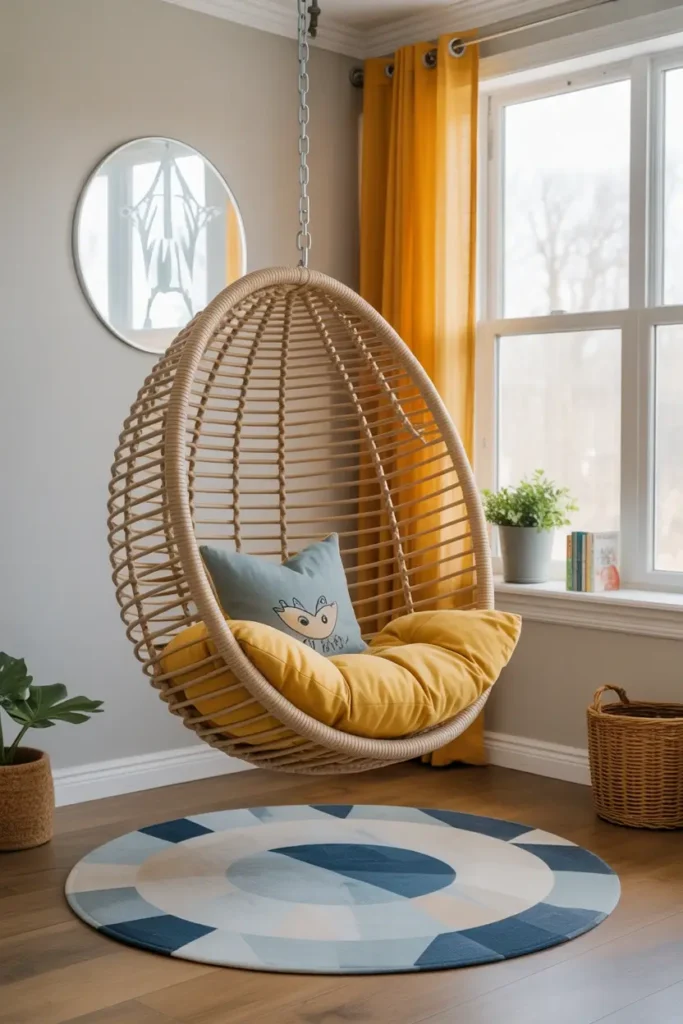
65. Create a Craft Station
A craft station keeps art supplies in order. Use labeled bins for paints, paper, and tools. A small table gives space for projects. Kids stay focused when materials are easy to find. It makes creativity part of everyday play.
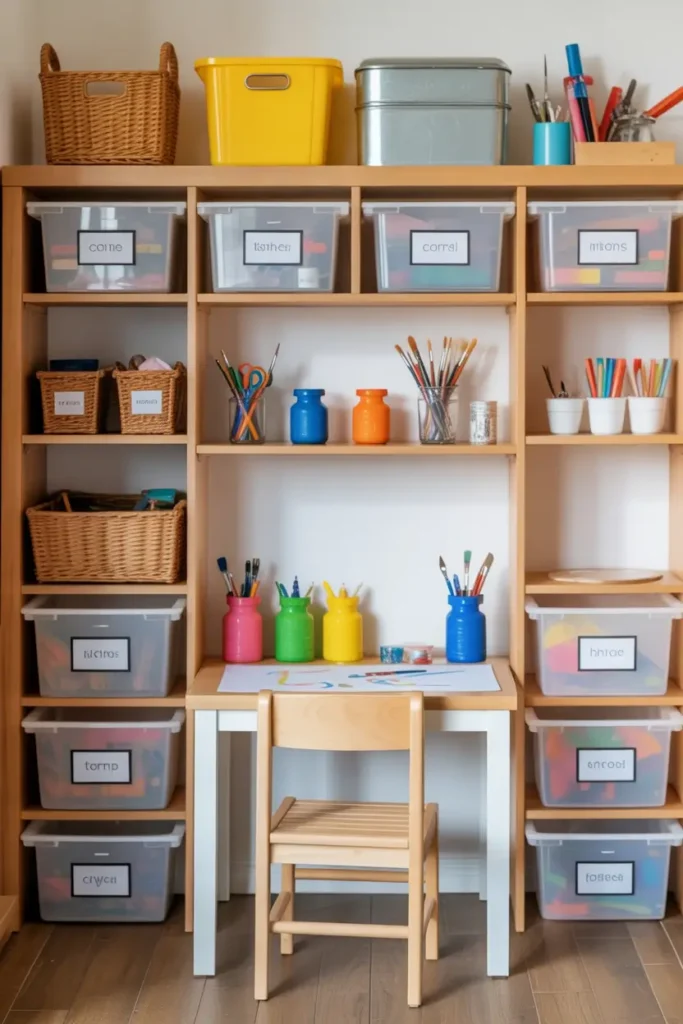
66. Add Canopy Beds
Canopy beds bring instant charm to a room. Sheer fabric creates a dreamy, soft look. Kids enjoy the cozy, enclosed feeling. You can change the fabric as styles shift. It makes bedtime more inviting and fun.
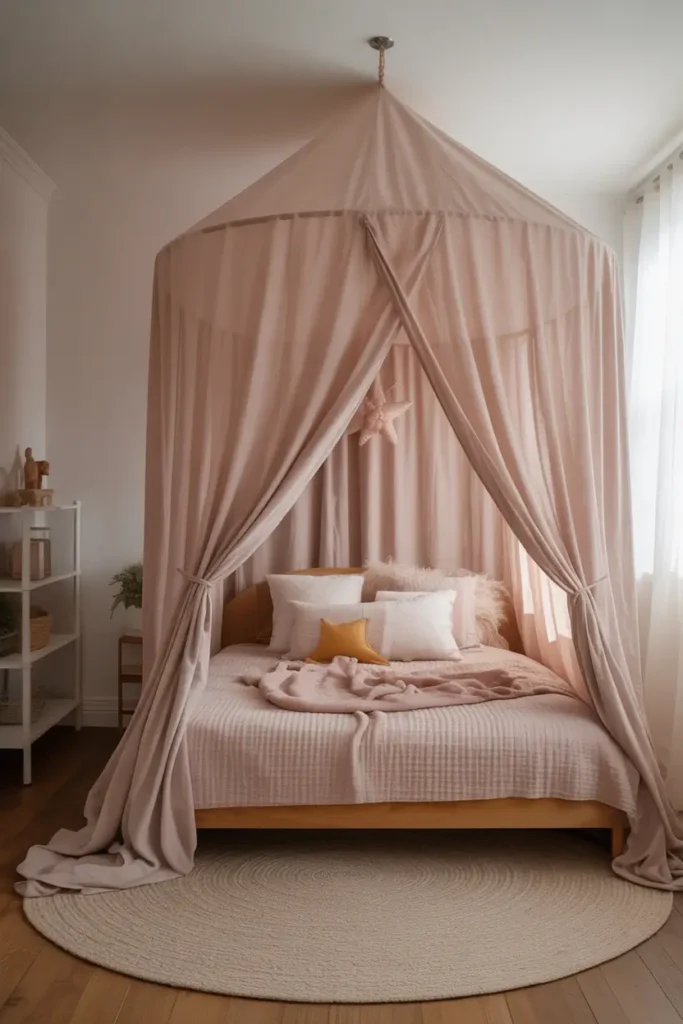
67. Install Pegboards
Pegboards keep walls practical and playful. Hooks hold bags, hats, or art supplies. Shelves add extra room for books or toys. Kids can rearrange things as they like. The setup is easy to update anytime.
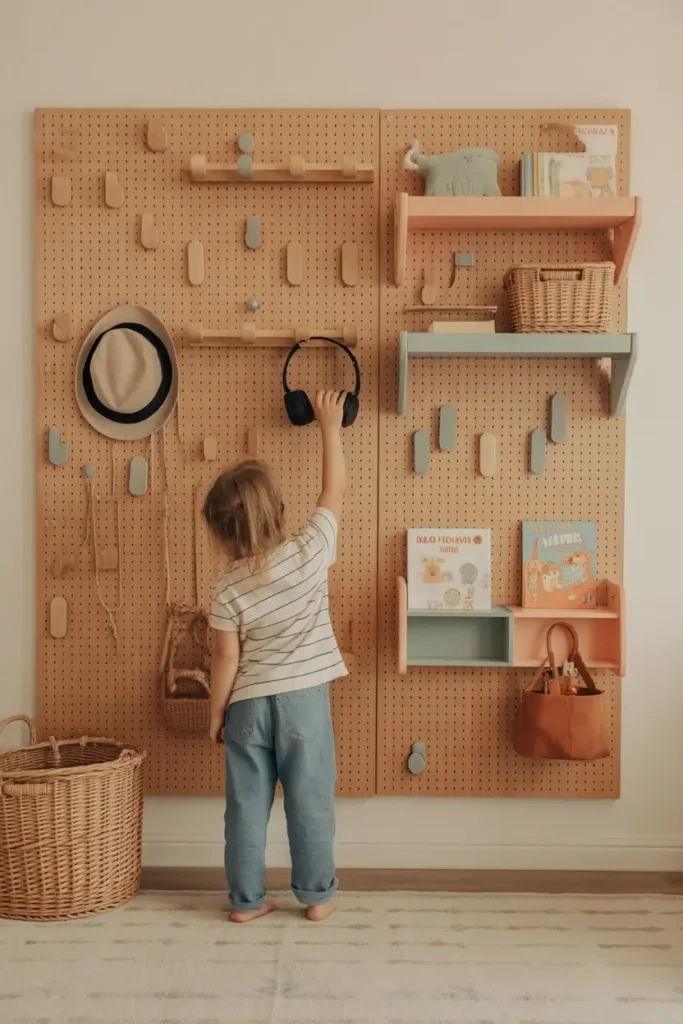
68. Mix Old and New Pieces
Combining old and new furniture adds character. A vintage chair pairs well with modern desks. The contrast feels unique and timeless. Kids’ rooms gain style without looking too themed. It’s a simple way to balance charm and function.
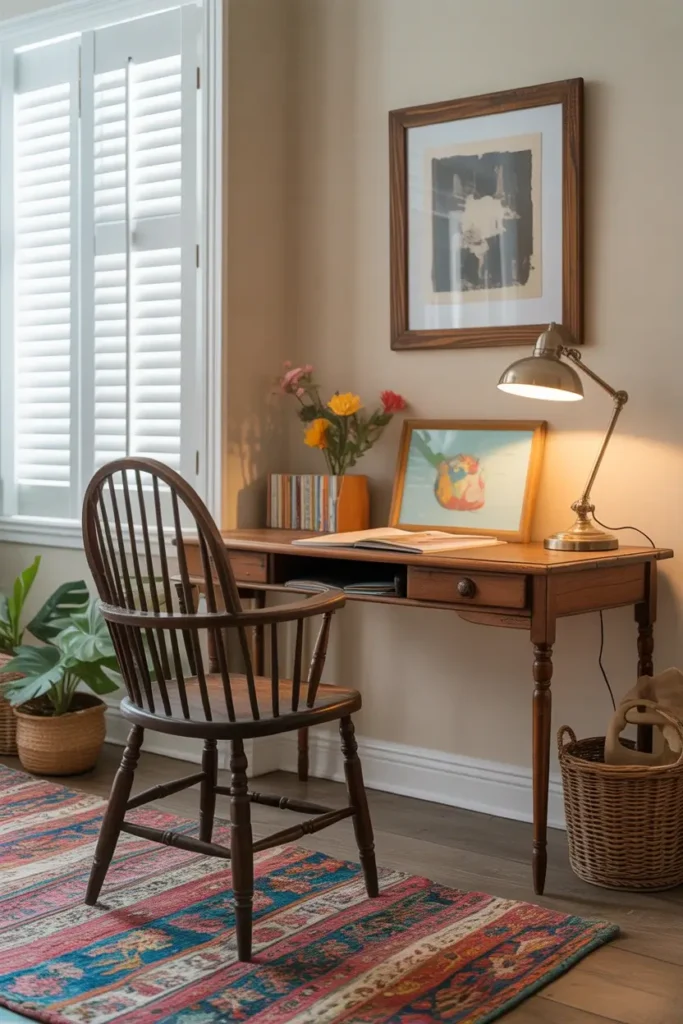
69. Try Built-In Storage
Built-ins save space while keeping the room neat. Beds with drawers or wall units work best. They hide clutter while staying easy to use. Kids learn to keep things in order naturally. The room feels clean without losing warmth.
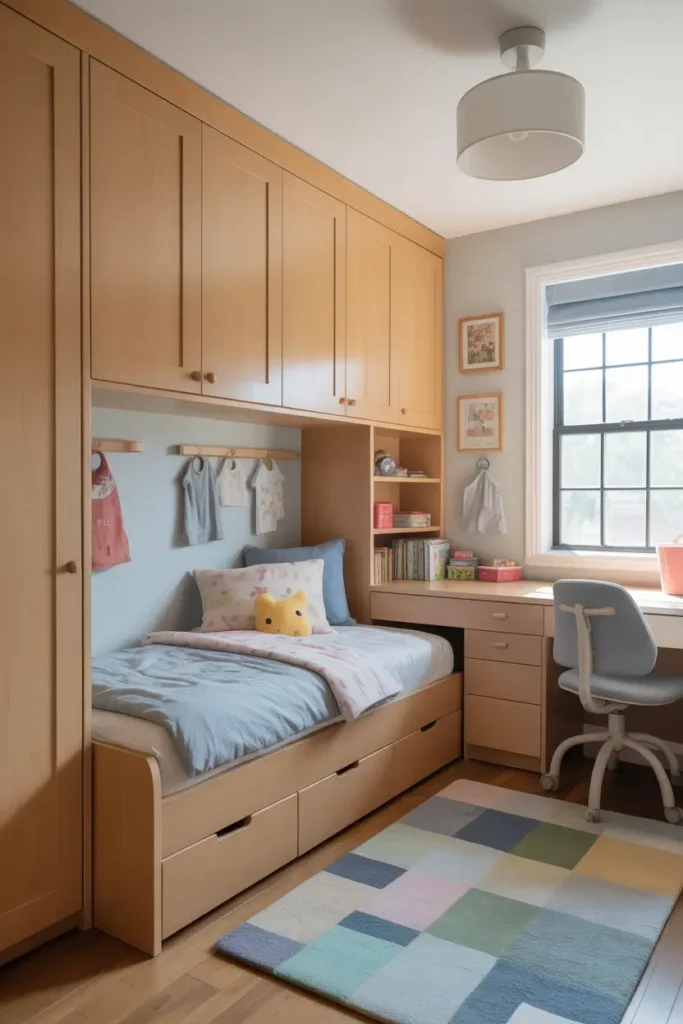
70. Use Bold Curtains
Curtains can add more than privacy. Bright colors or patterns change the whole room mood. Kids enjoy playful prints that reflect their taste. They’re easy to switch as styles change. Curtains finish the space with a simple touch.
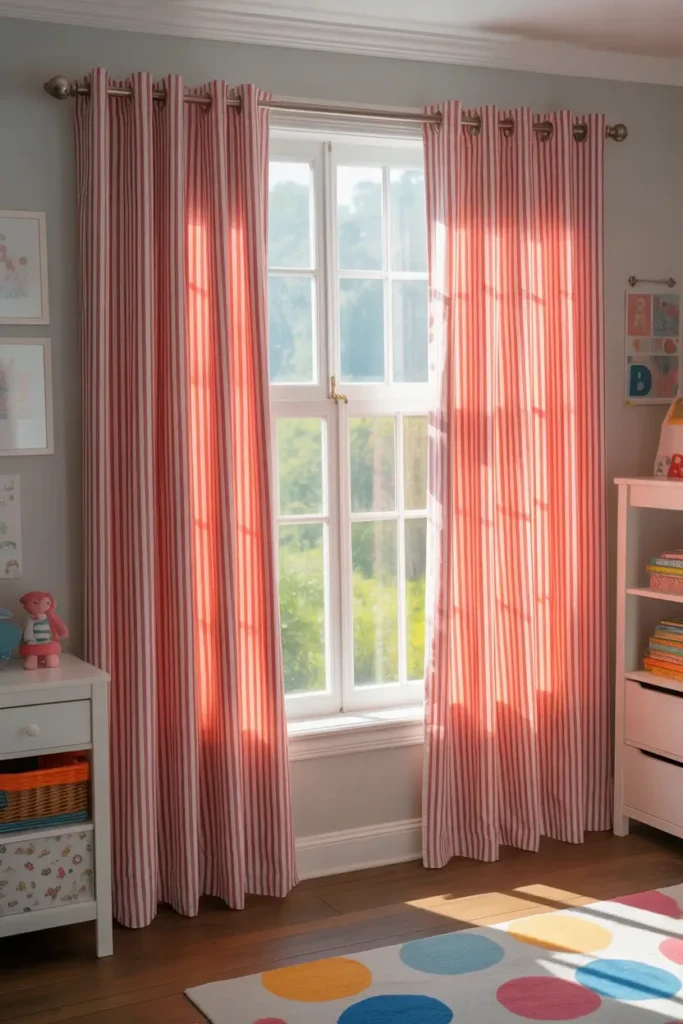
71. Create a Reading Loft
A small loft makes reading more exciting. Add railings, cushions, and good lighting. Kids enjoy climbing up to their private corner. The setup saves floor space for play. It becomes a special retreat for quiet time.
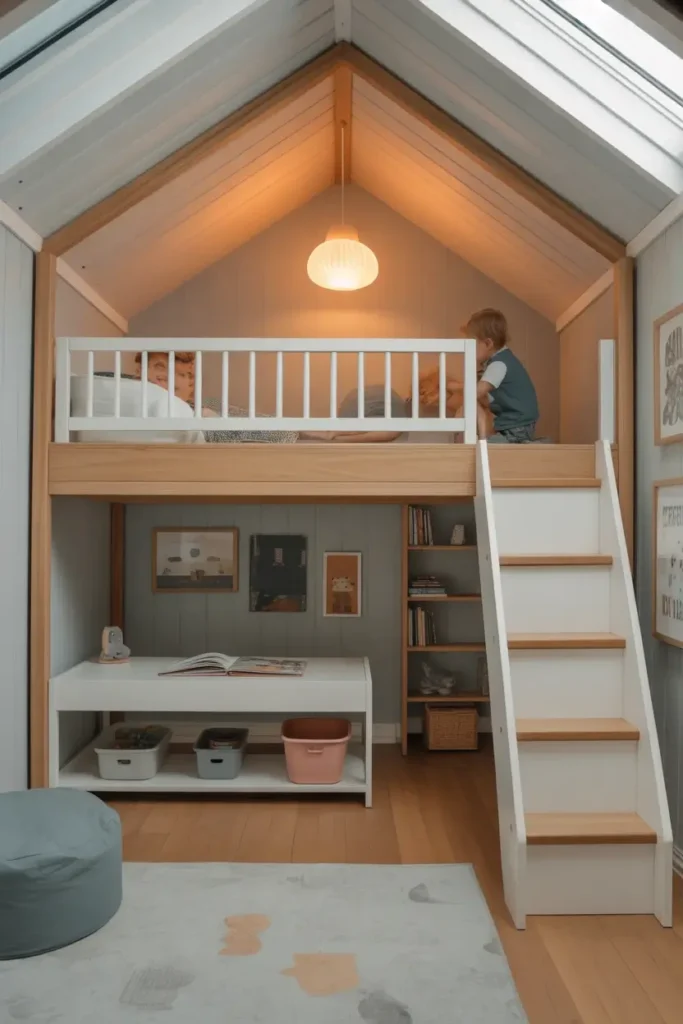
72. Use Floor Cushions
Floor cushions give flexible seating options. Kids can drag them anywhere for games or stories. Bright covers add color and texture easily. They’re lightweight and simple to clean. This keeps the room fun and practical.
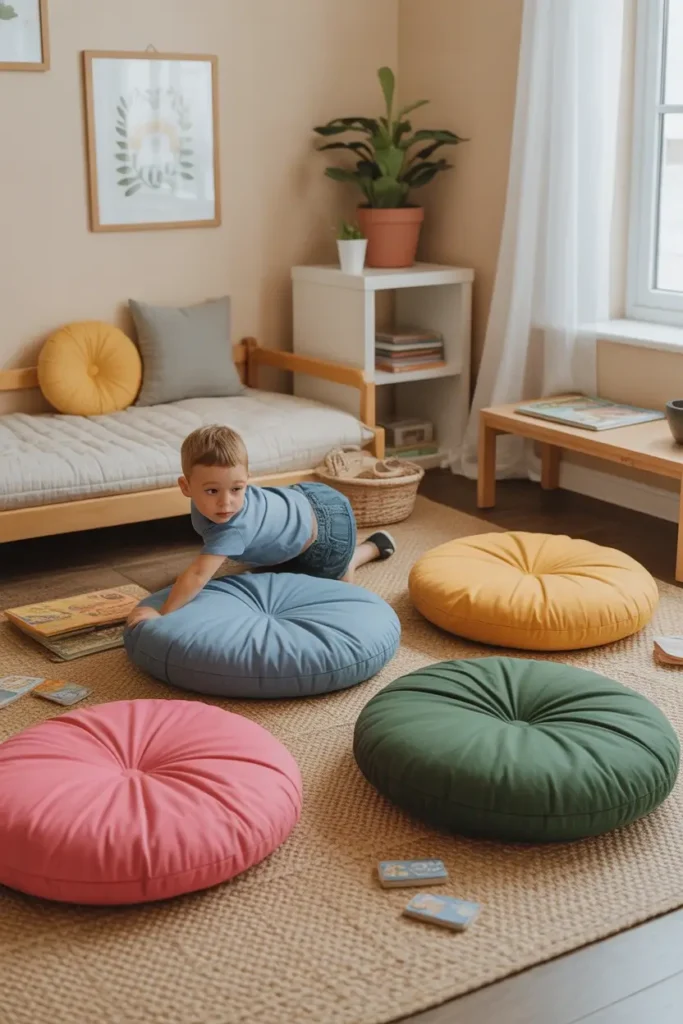
73. Add Glow-in-the-Dark Details
Glow-in-the-dark stars or shapes spark imagination. The room feels magical once lights go off. Stickers or paint are cheap and removable. Kids love the surprise at bedtime. It creates fun without crowding the design.
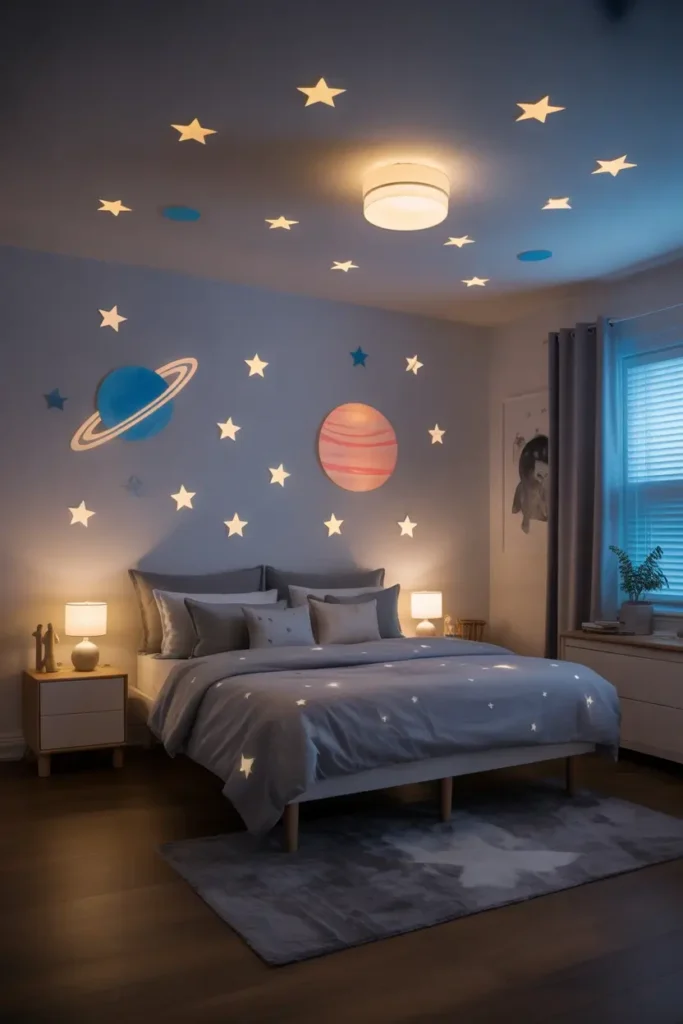
74. Display Favorite Collections
Shelves for collections make kids proud. Action figures, dolls, or cars stay organized and visible. The display changes as their interests shift. It also doubles as decor on the walls. Collections feel special without cluttering the space.
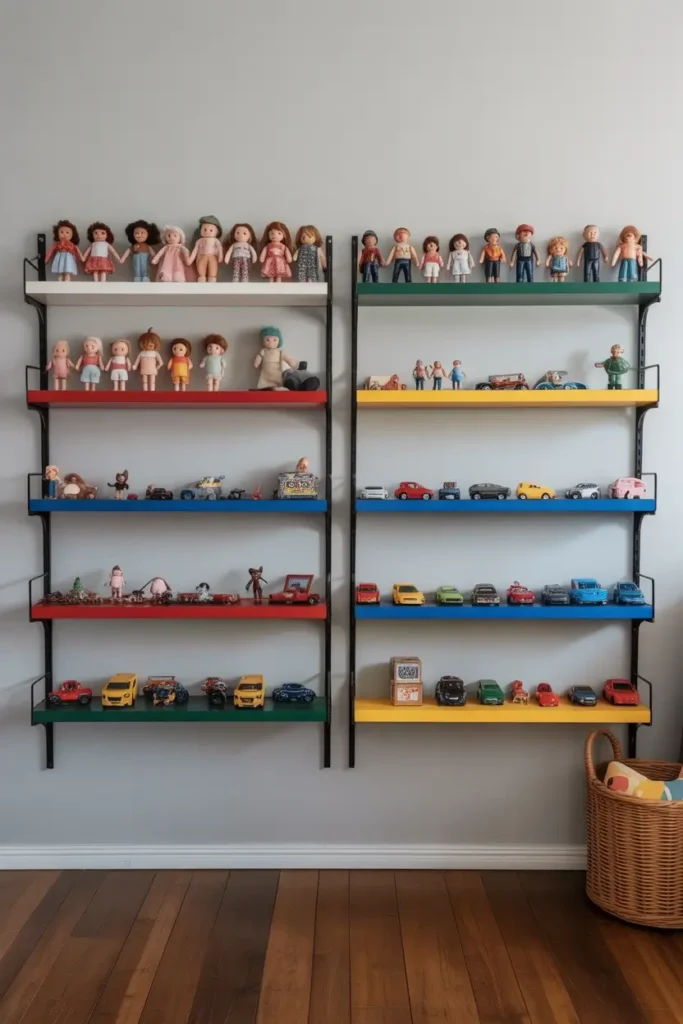
75. Try a Nature Corner
A corner with plants brings calmness inside. Choose easy plants like ferns or succulents. Kids learn care and responsibility naturally. Add small planters or hanging pots for variety. The room feels fresh and more inviting.
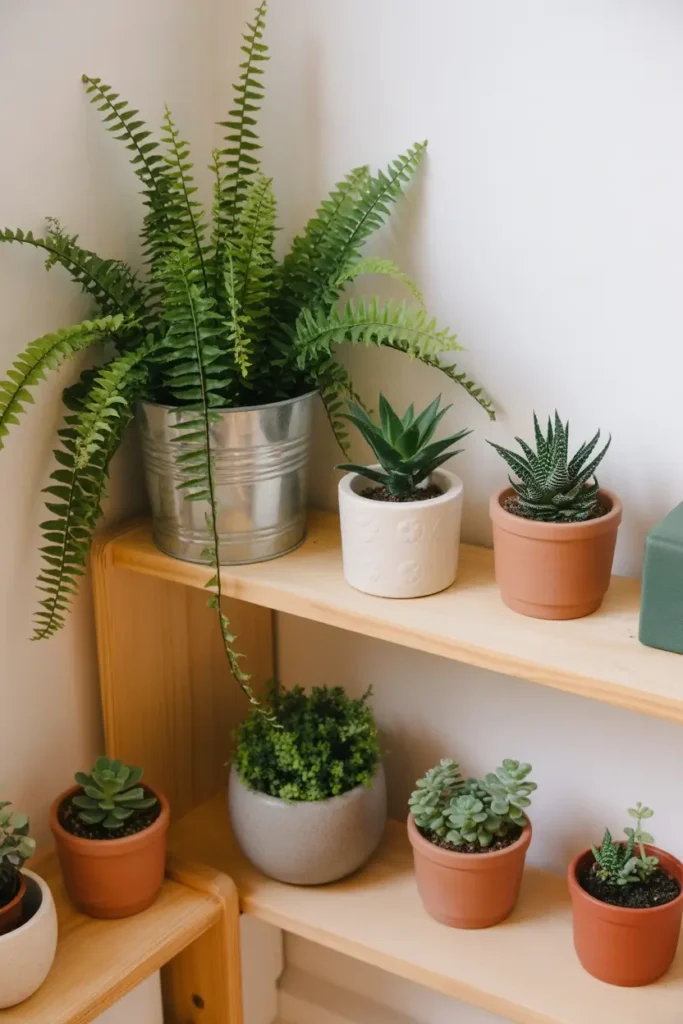
76. Add Wall Murals
Wall murals make a big impact fast. Choose clouds, forests, or geometric designs. Kids enjoy the bold art every day. Peel-and-stick murals are simple to replace. The room stays fresh as their style changes.
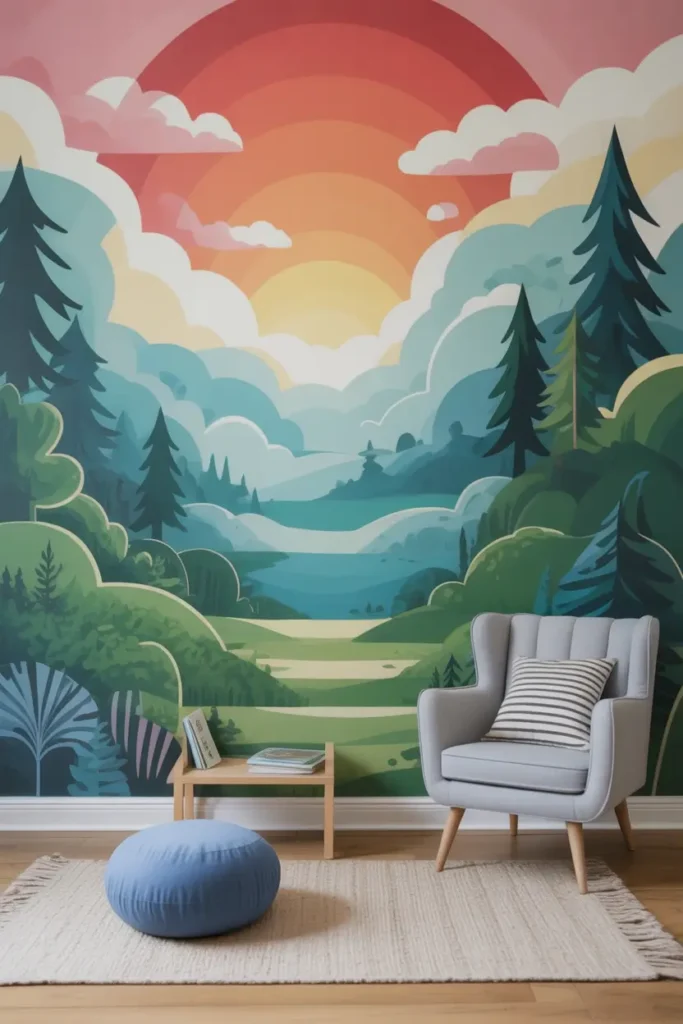
77. Use Ladder Shelves
Ladder shelves save space and look modern. They hold books, plants, or toys neatly. Kids can reach lower shelves with ease. The angled design adds interest to walls. It’s practical storage with a stylish touch.
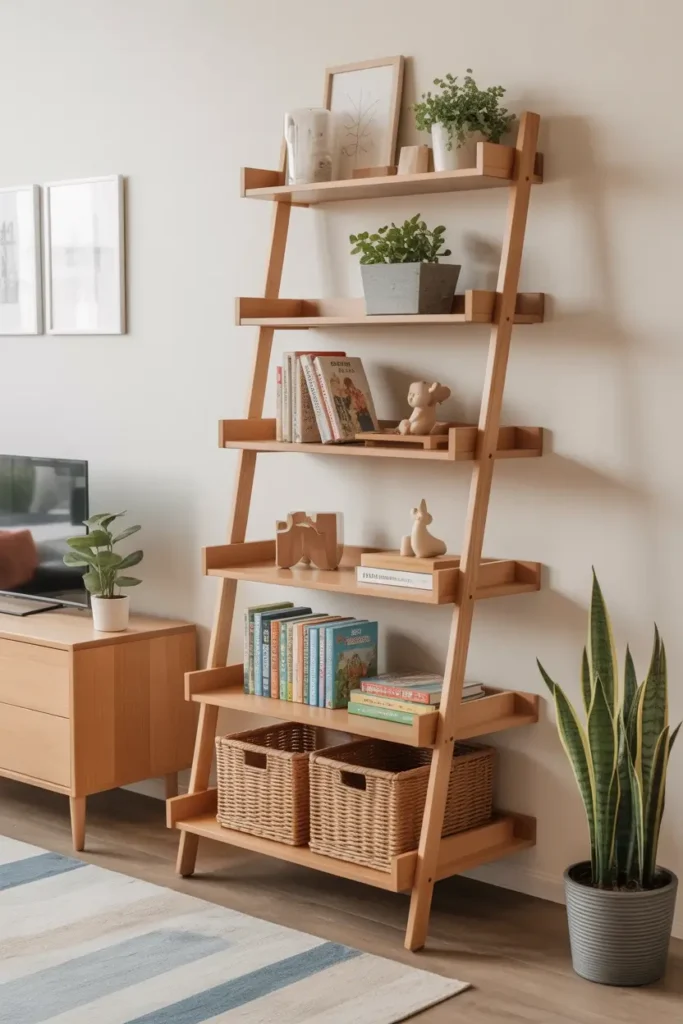
78. Create Hidden Storage
Hidden storage keeps clutter out of sight. Benches with lift-up seats work well. Beds with drawers are another smart choice. Kids learn to tuck things away quickly. The room feels tidy without extra effort.
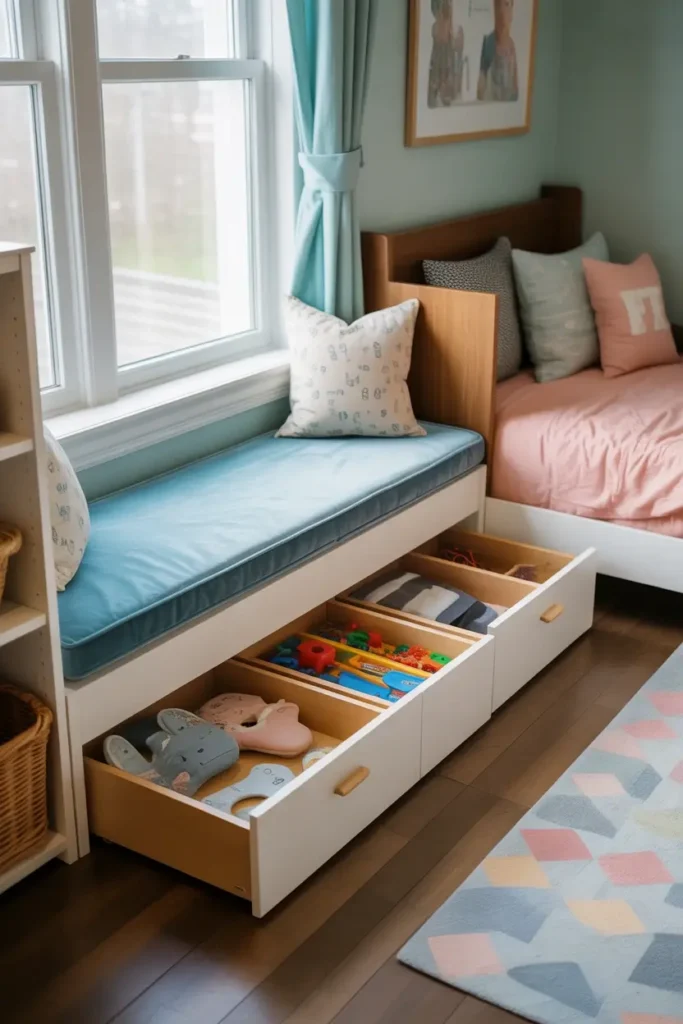
79. Add Swing Seats
Swing seats bring energy into the space. They’re perfect for reading or gentle play. Kids enjoy the motion while staying indoors. Cushions add comfort and color easily. The seat feels fun yet blends with the decor.
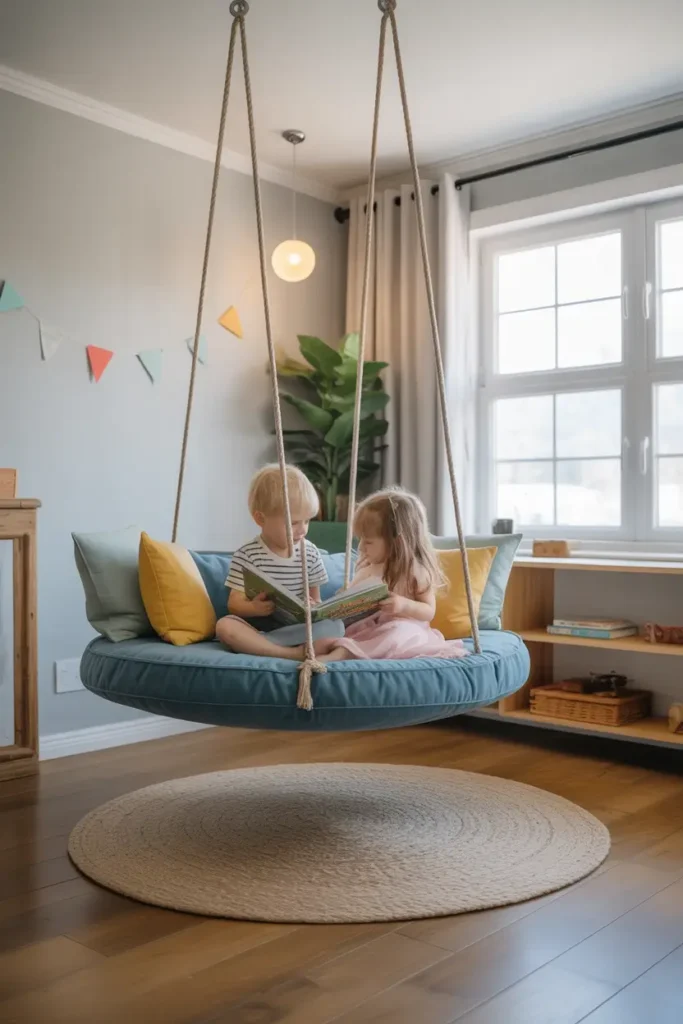
80. Try Patterned Bedding
Patterned bedding helps you to change a room. Stripes, florals, or stars add playful style to kids room. Sheets and covers are easy to swap. Kids love seeing their favorite designs nightly. It’s a budget-friendly way to refresh the space.
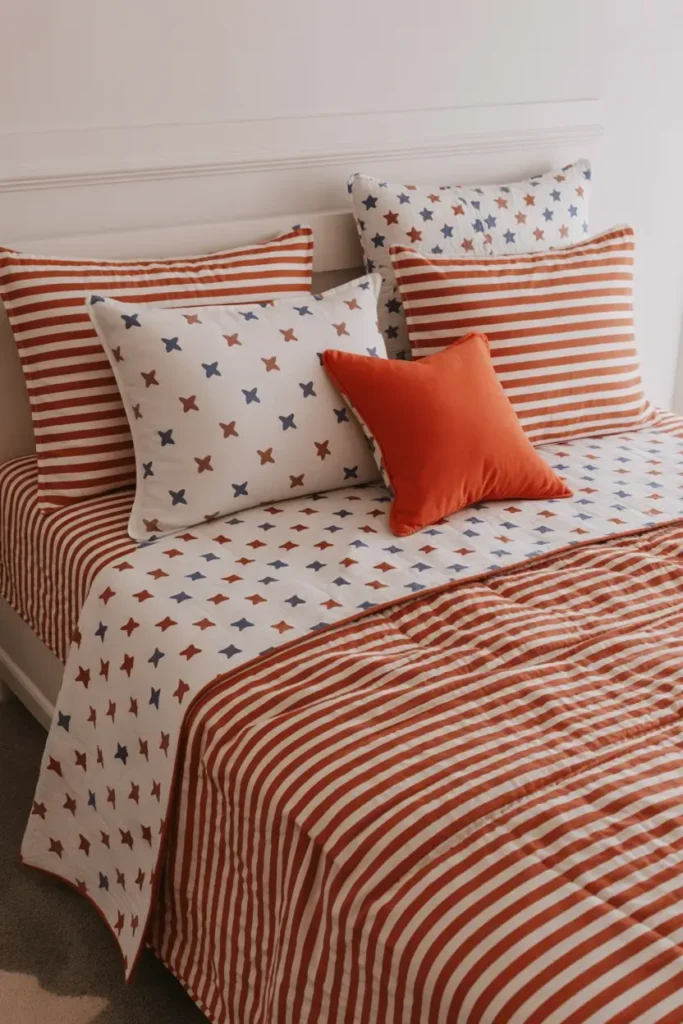
You may also like these guides
- Ultimate Guide to Luxe Home Decor: Elevate Your Space in 2026
- The Ultimate Guide to Pet-Friendly Glam Home Decor in 2026
- 53 Best Industrial Small Apartment Decor You Can Adopt Today
Conclusion
A traditional kids room gives your child comfort now and flexibility later. I give information From canopy beds to classic storage, every choice builds a room that feels both fun and lasting.
Small details like rugs, shelves, or soft lighting made a small kids room cute and loving. With these simple ideas, traditional kids room decor stays practical, stylish, and ready for every stage. Visit luxehomedecors.com for more exciting decor ideas.

